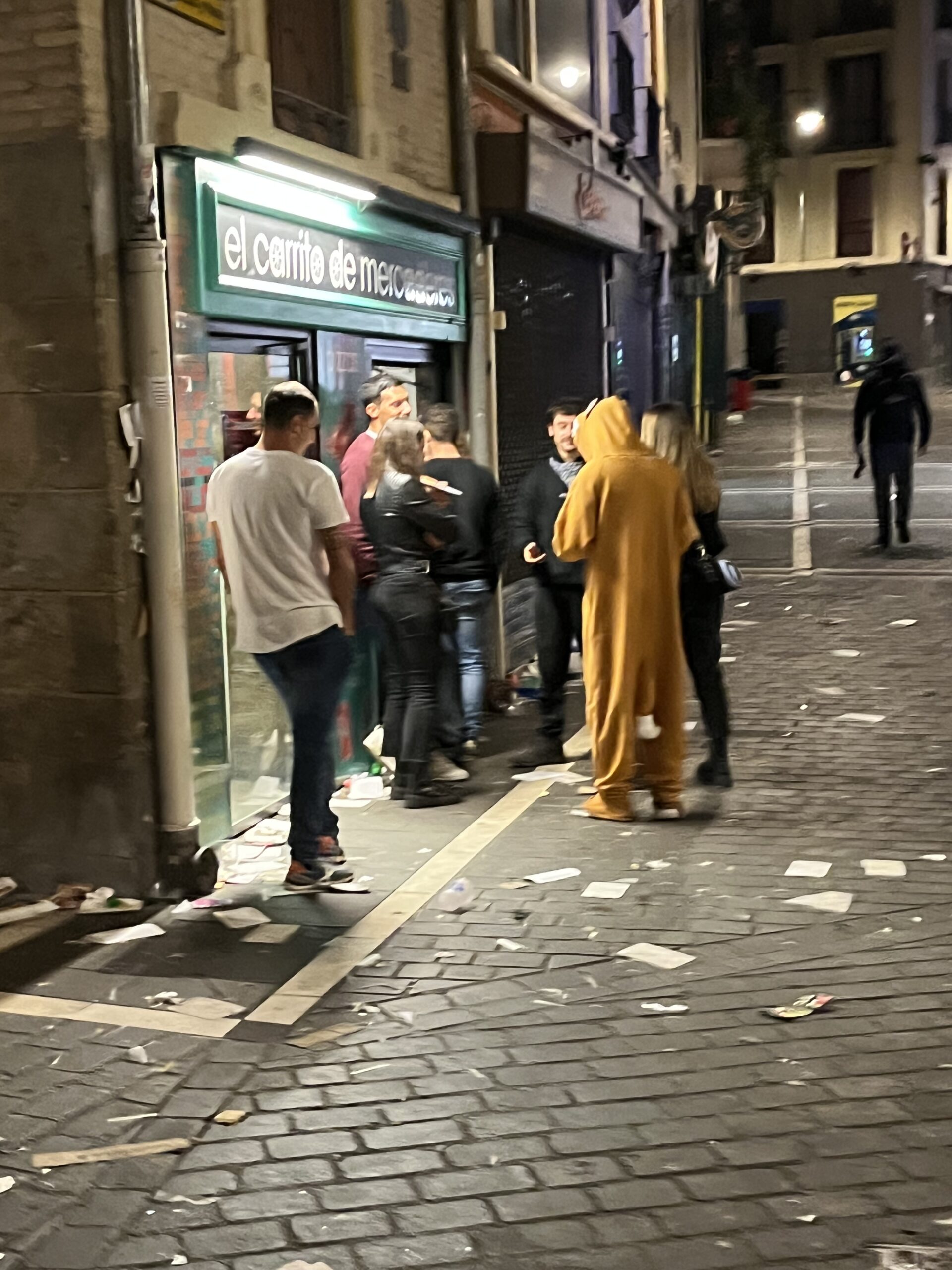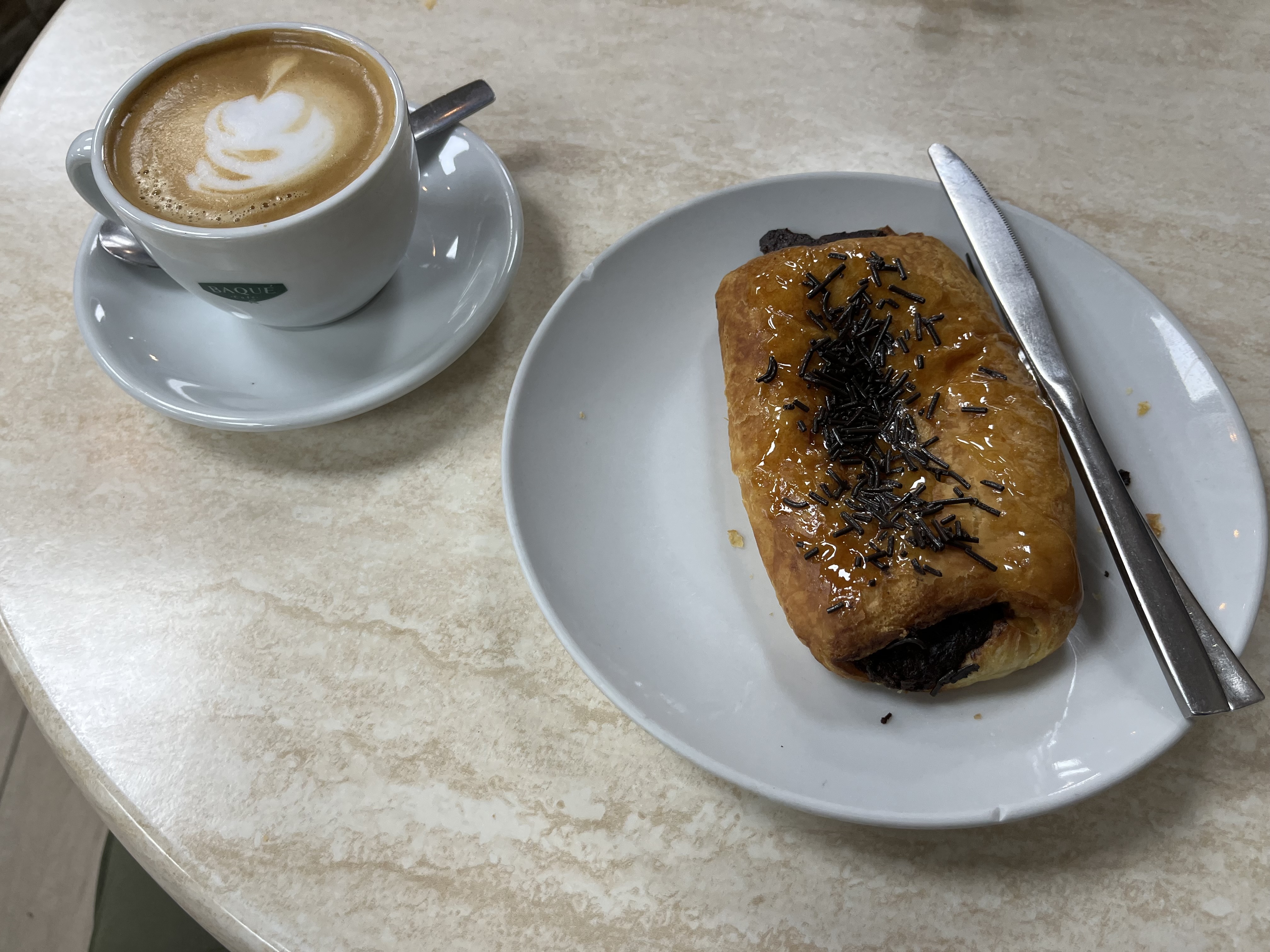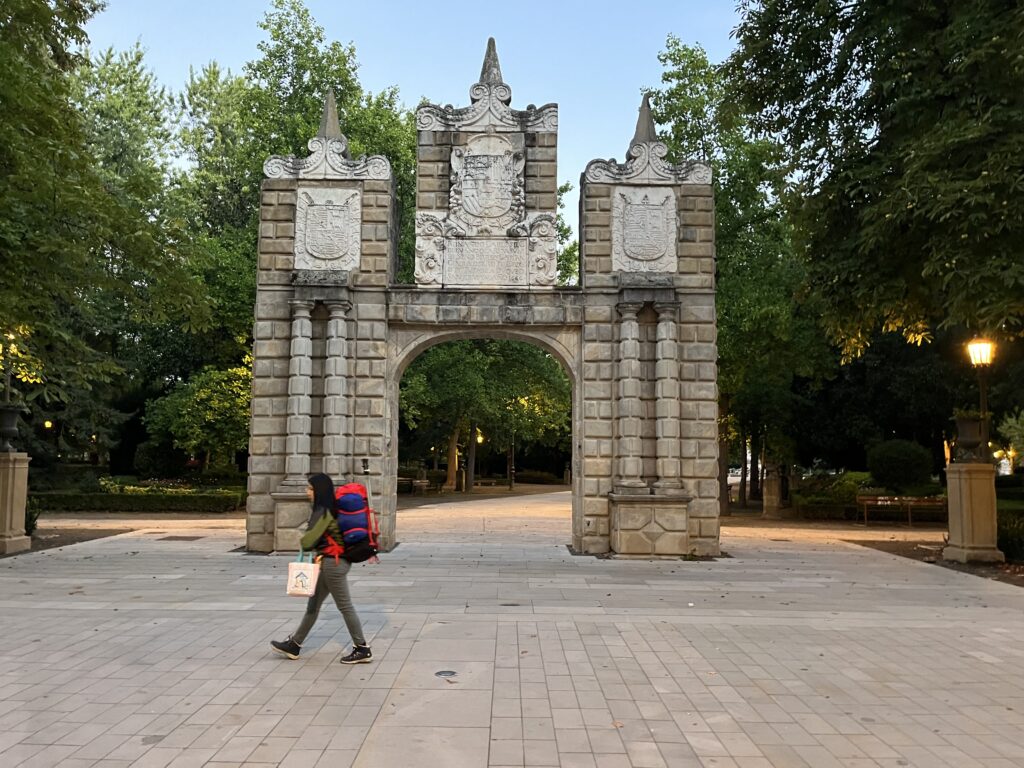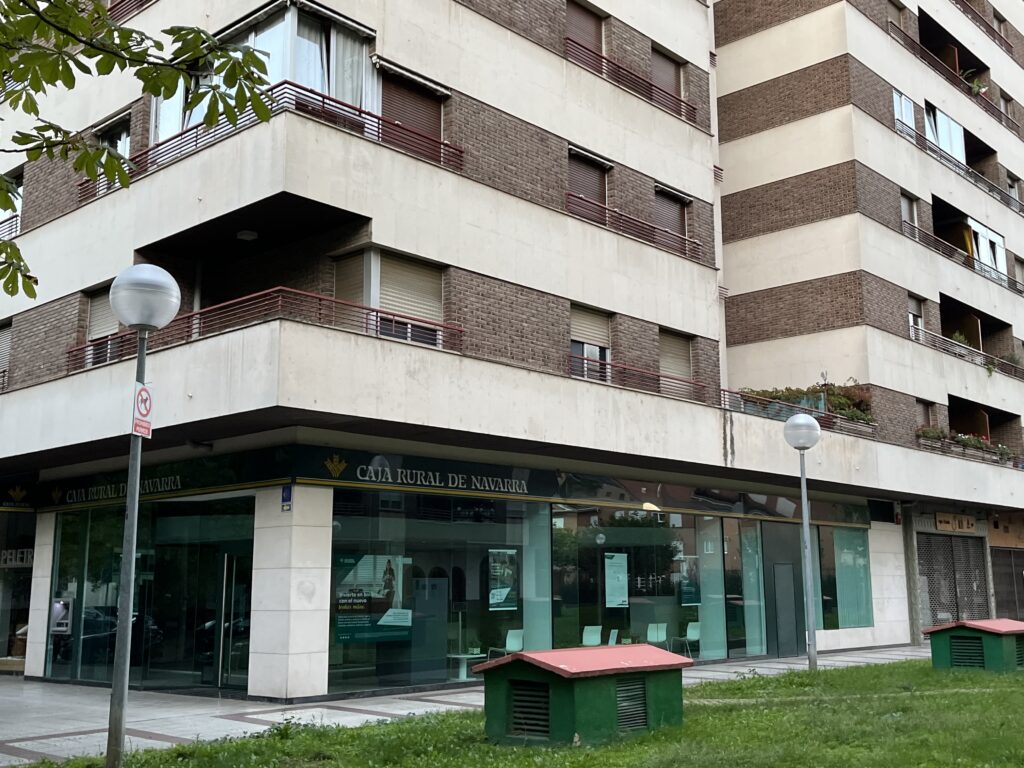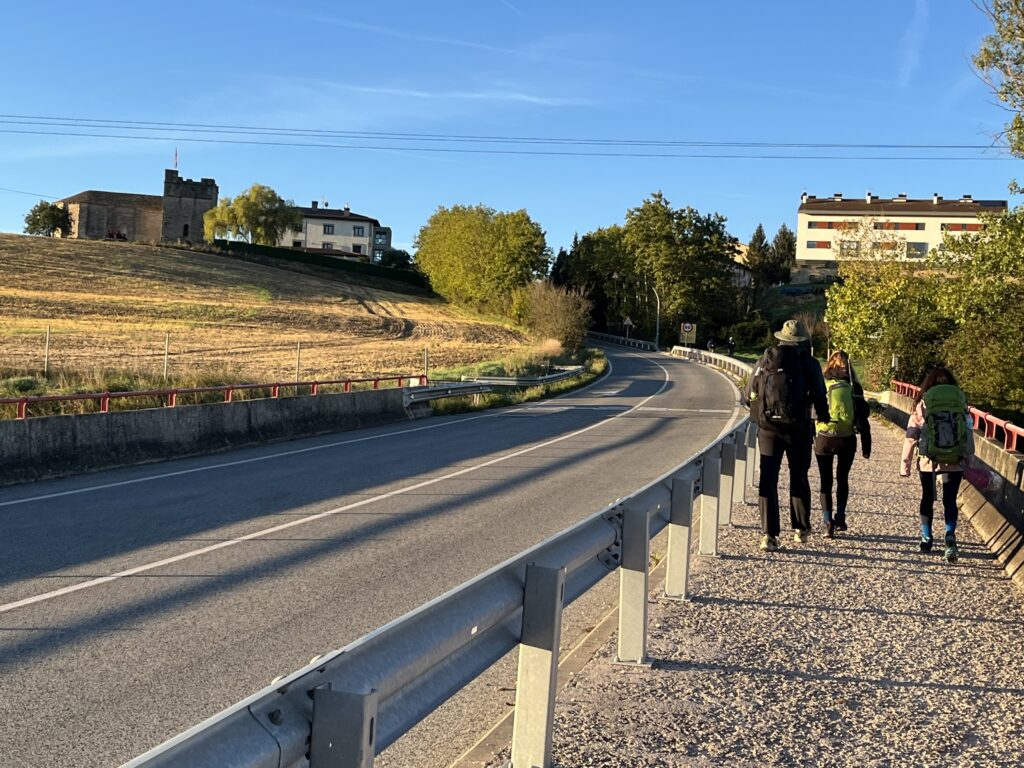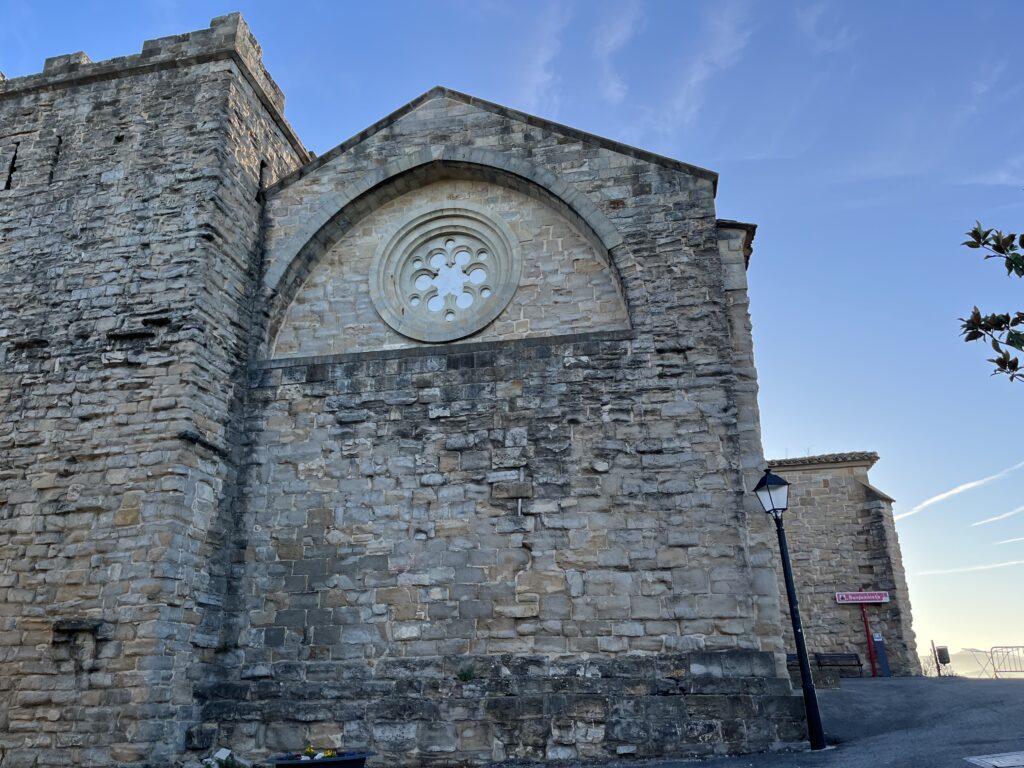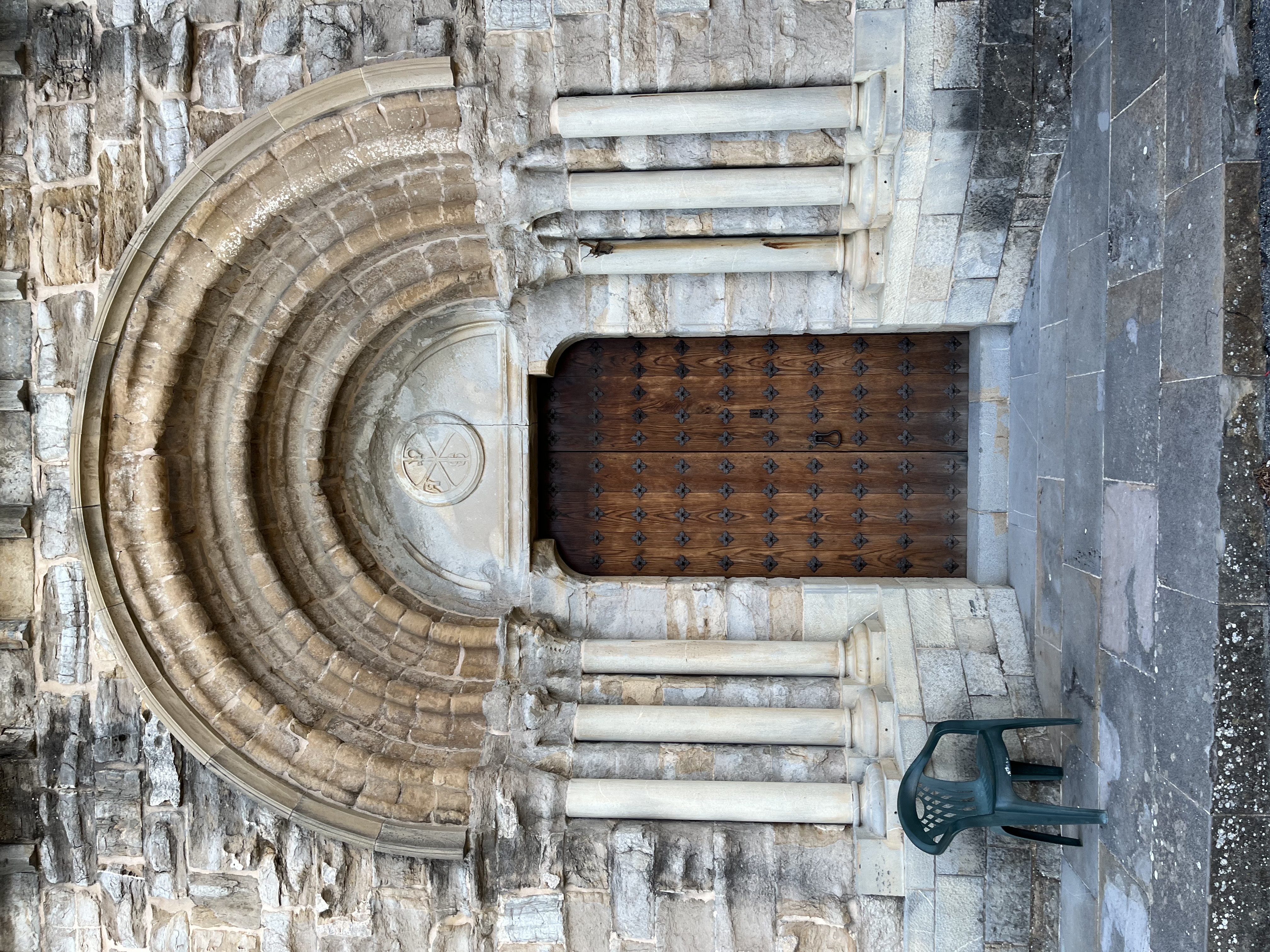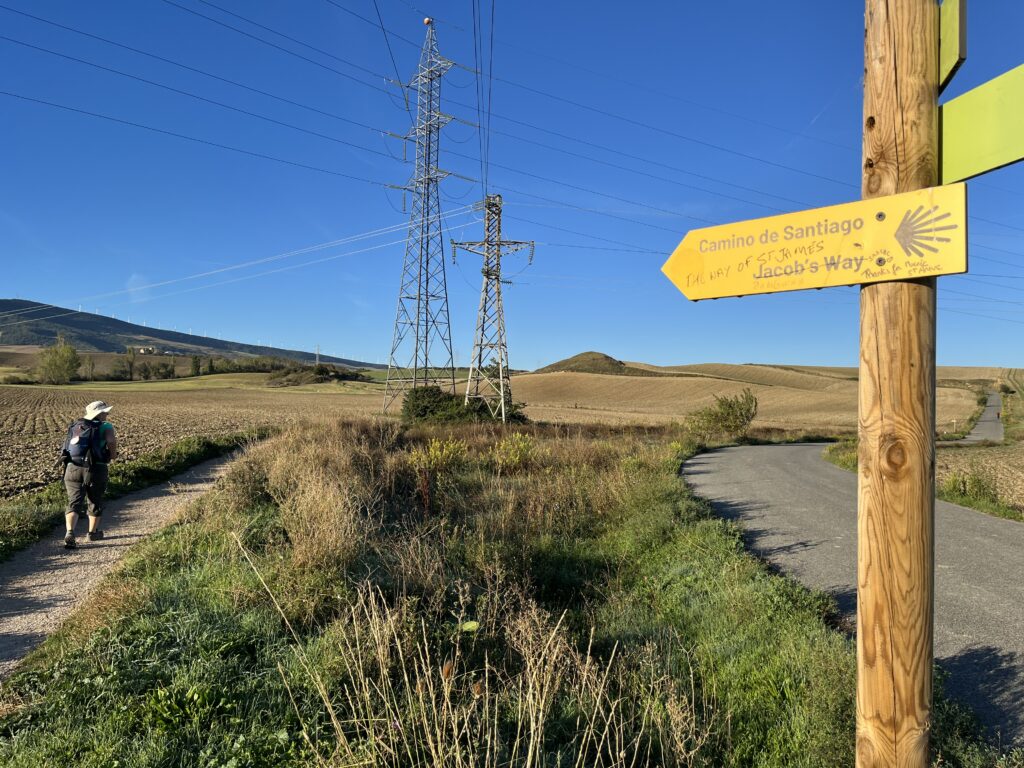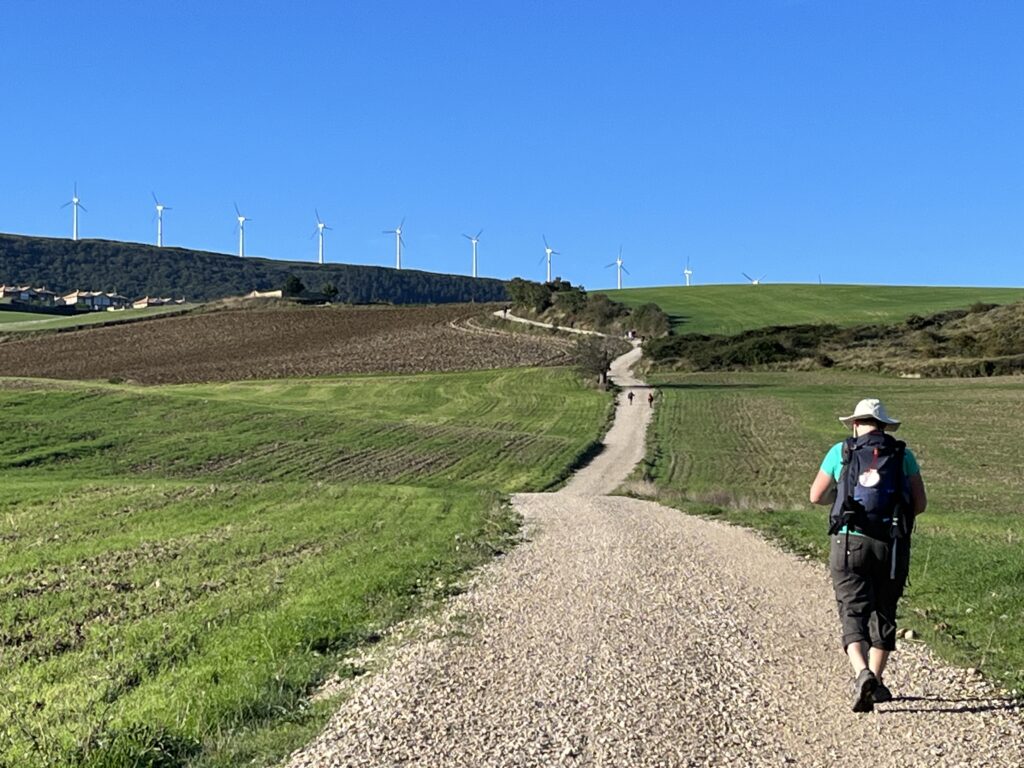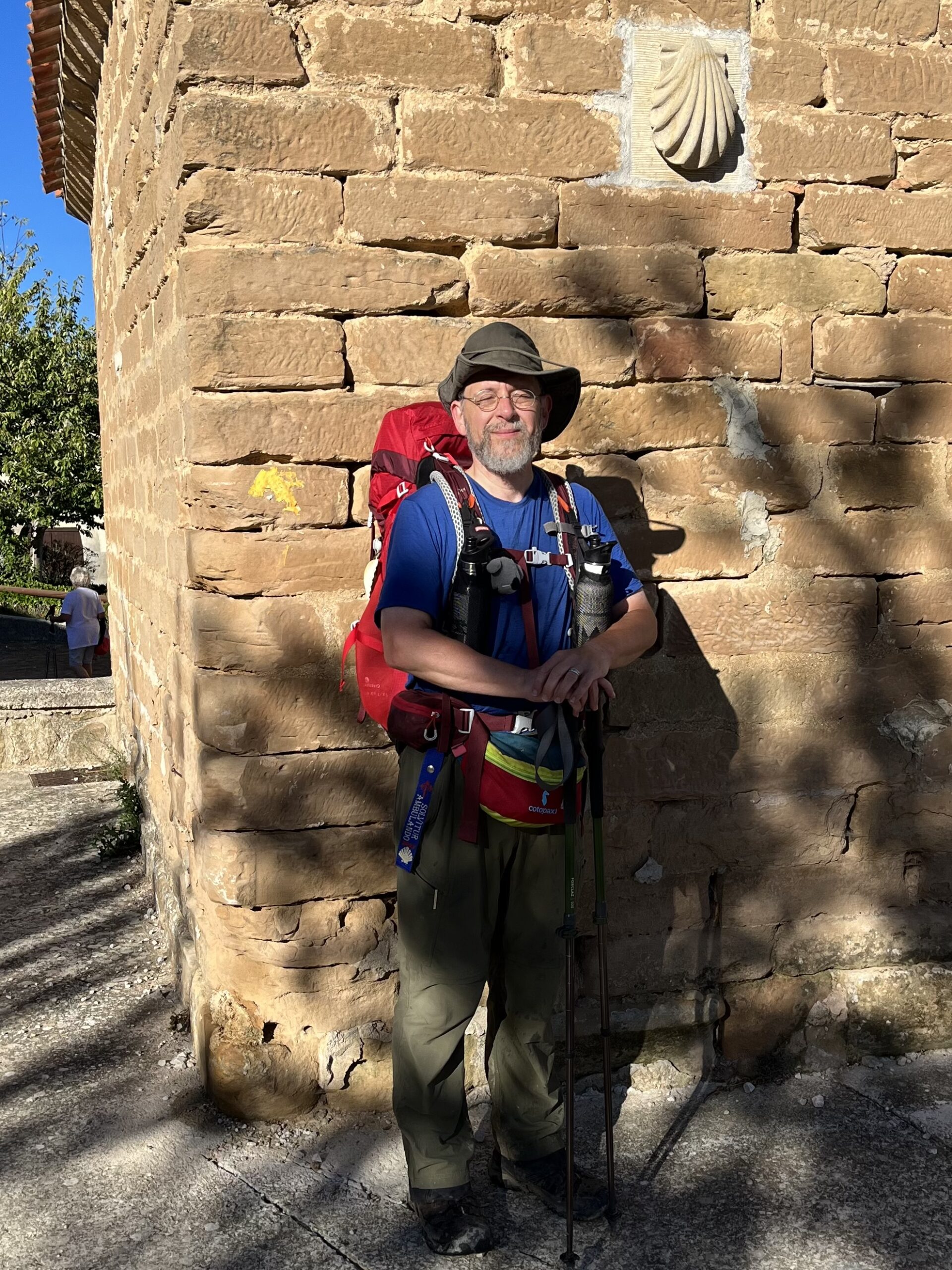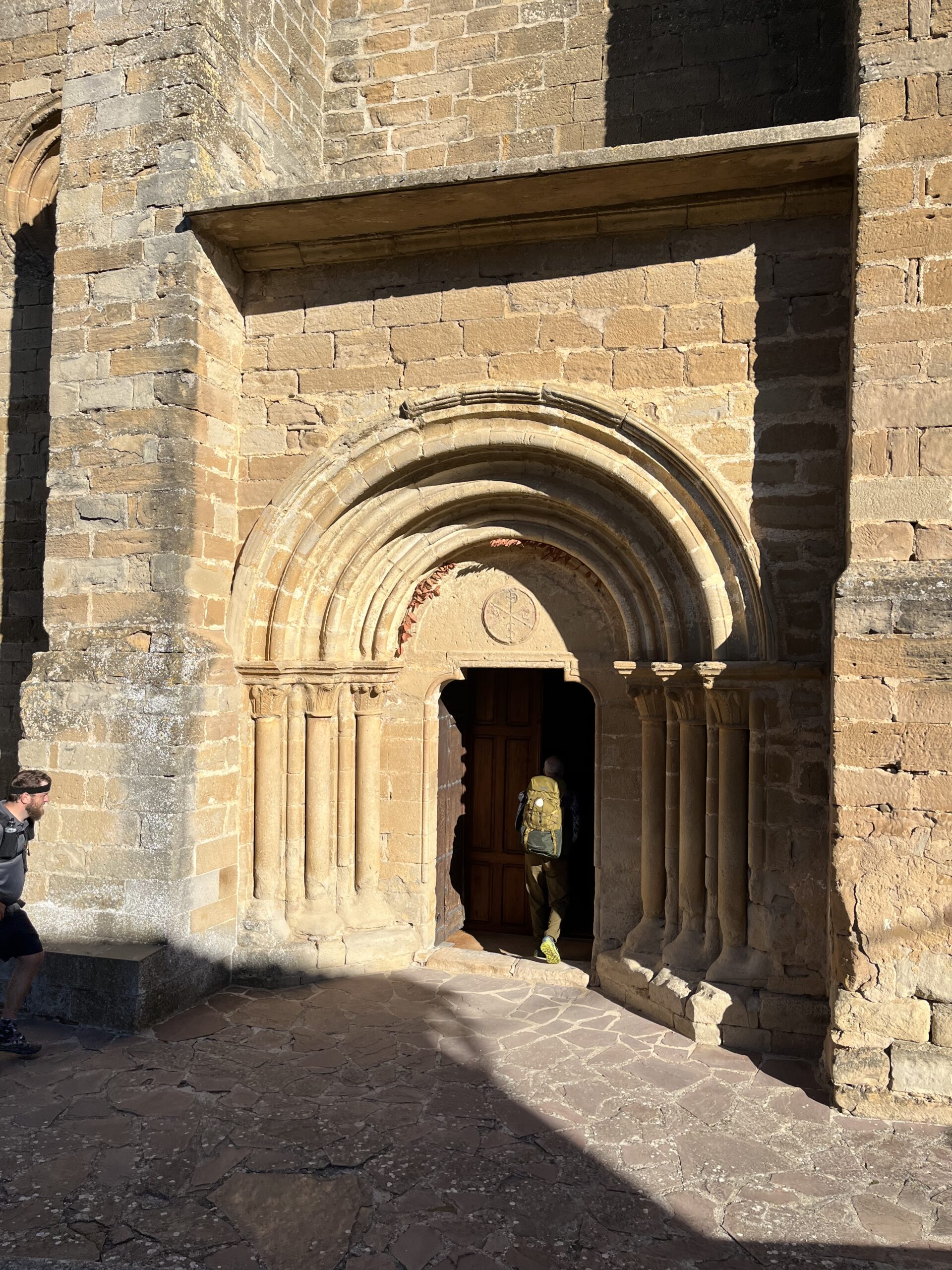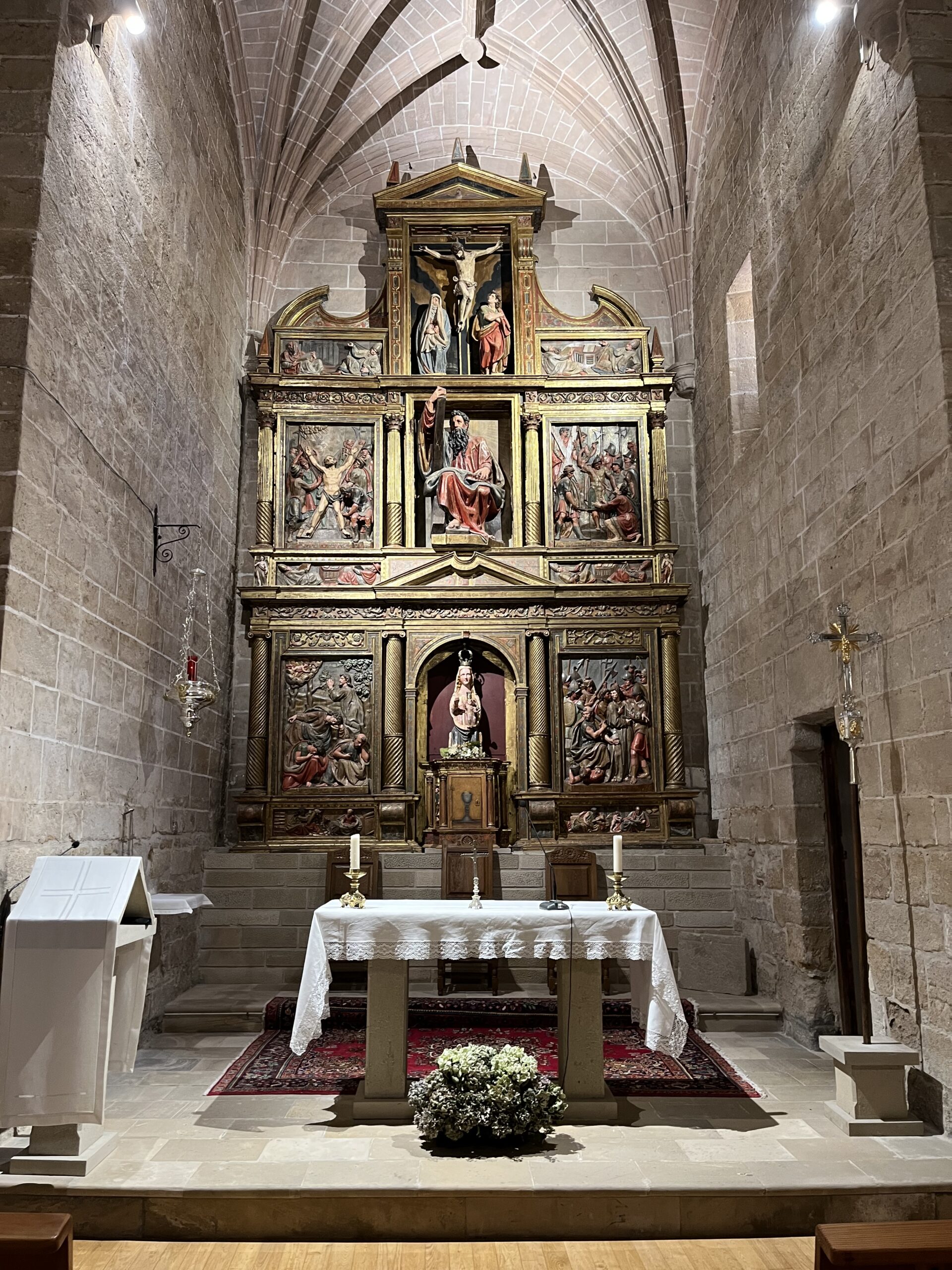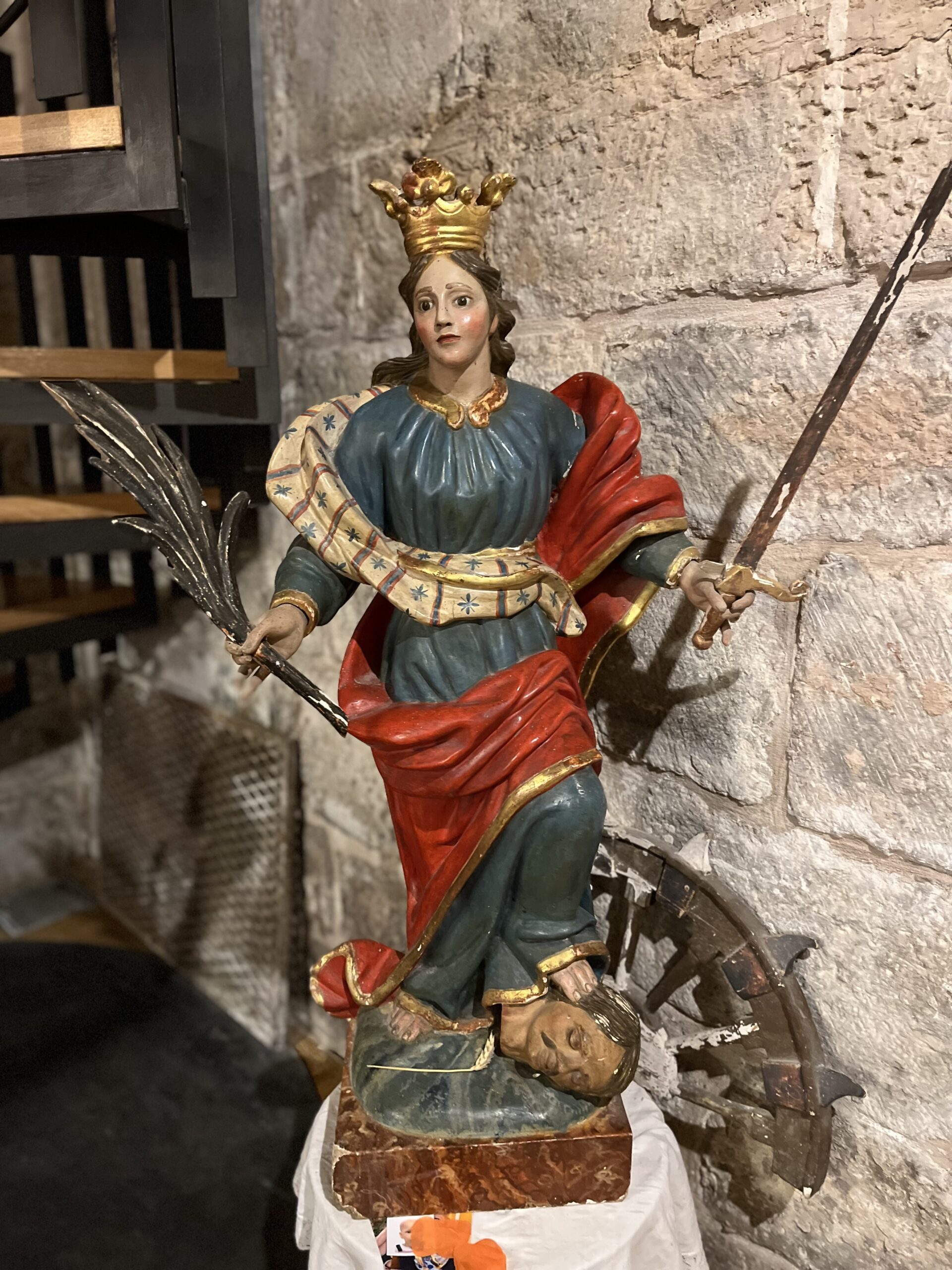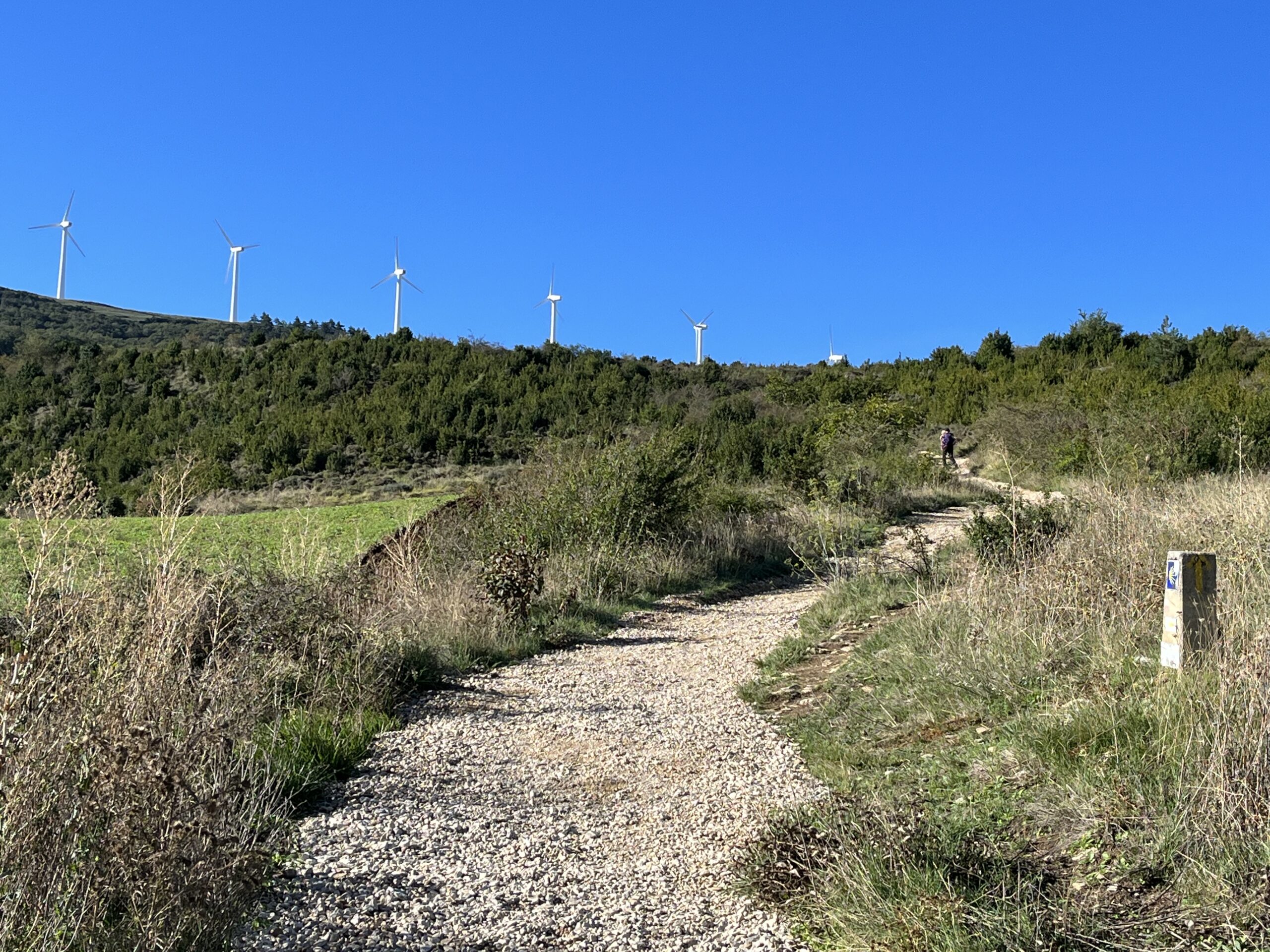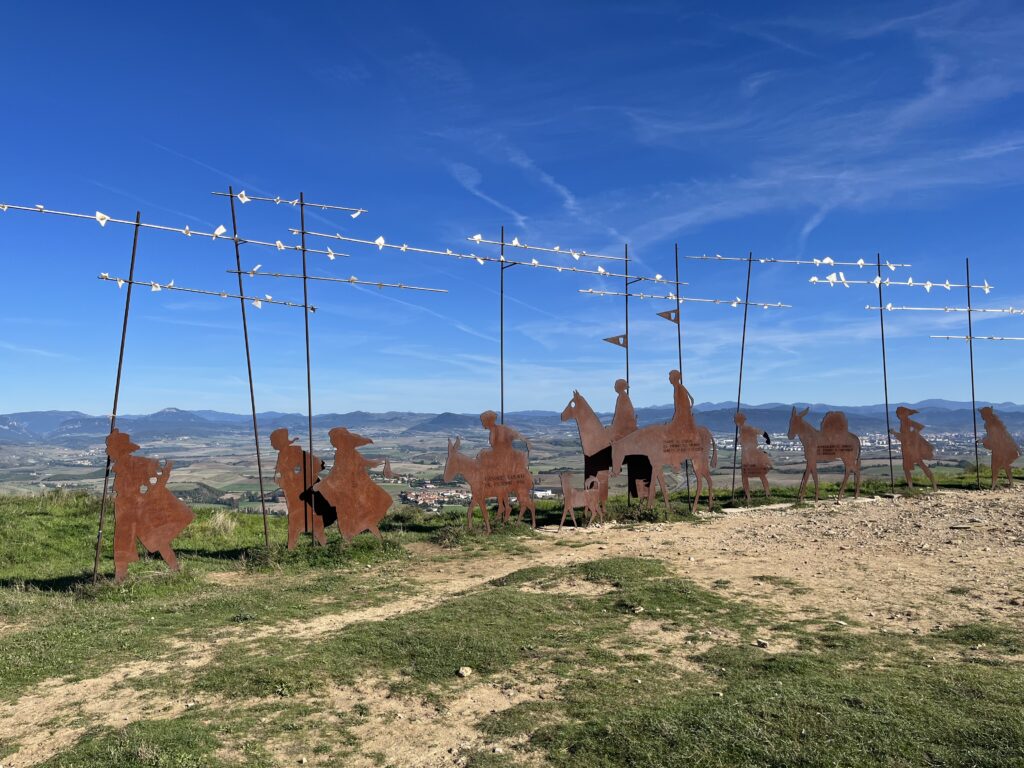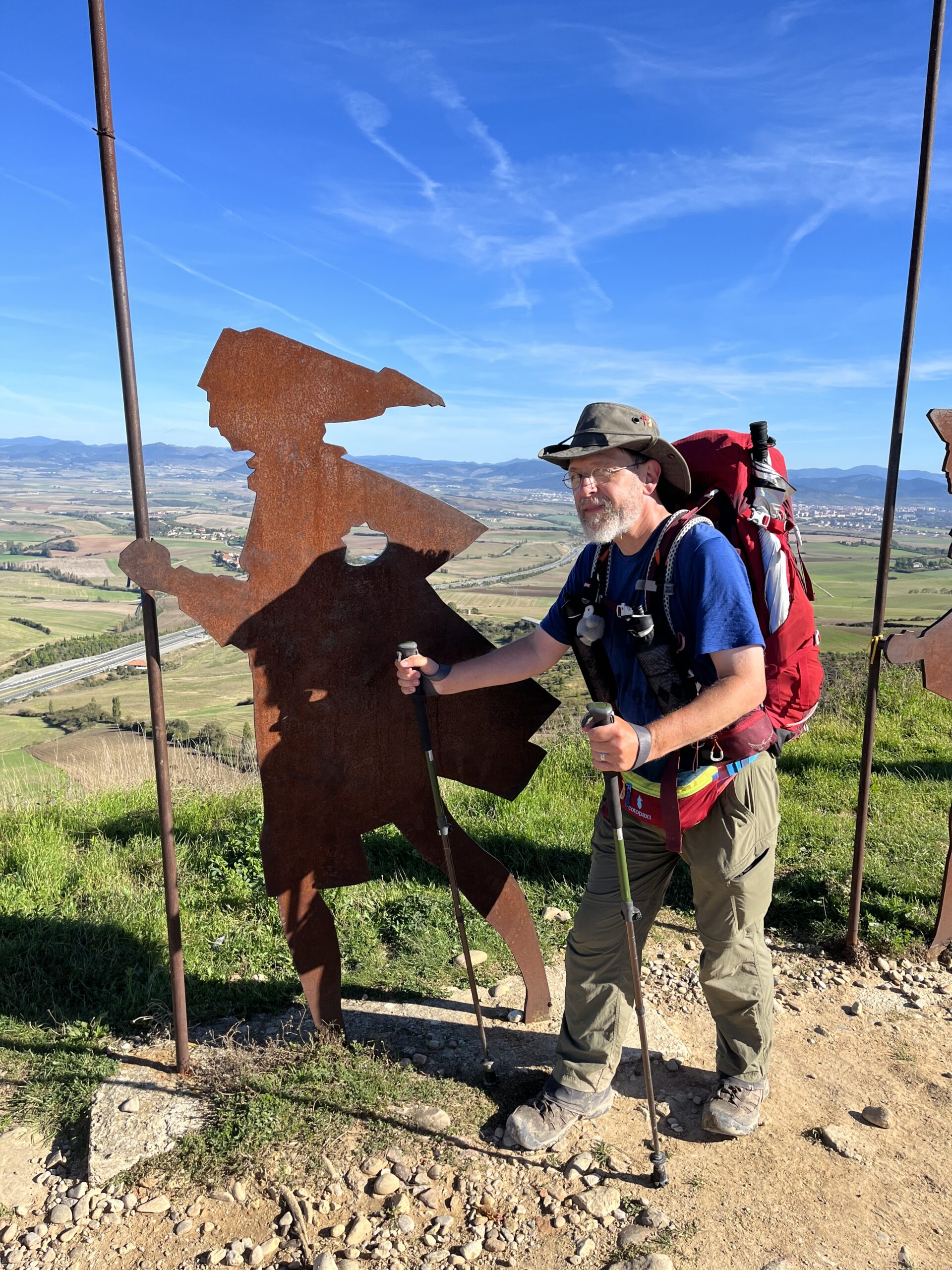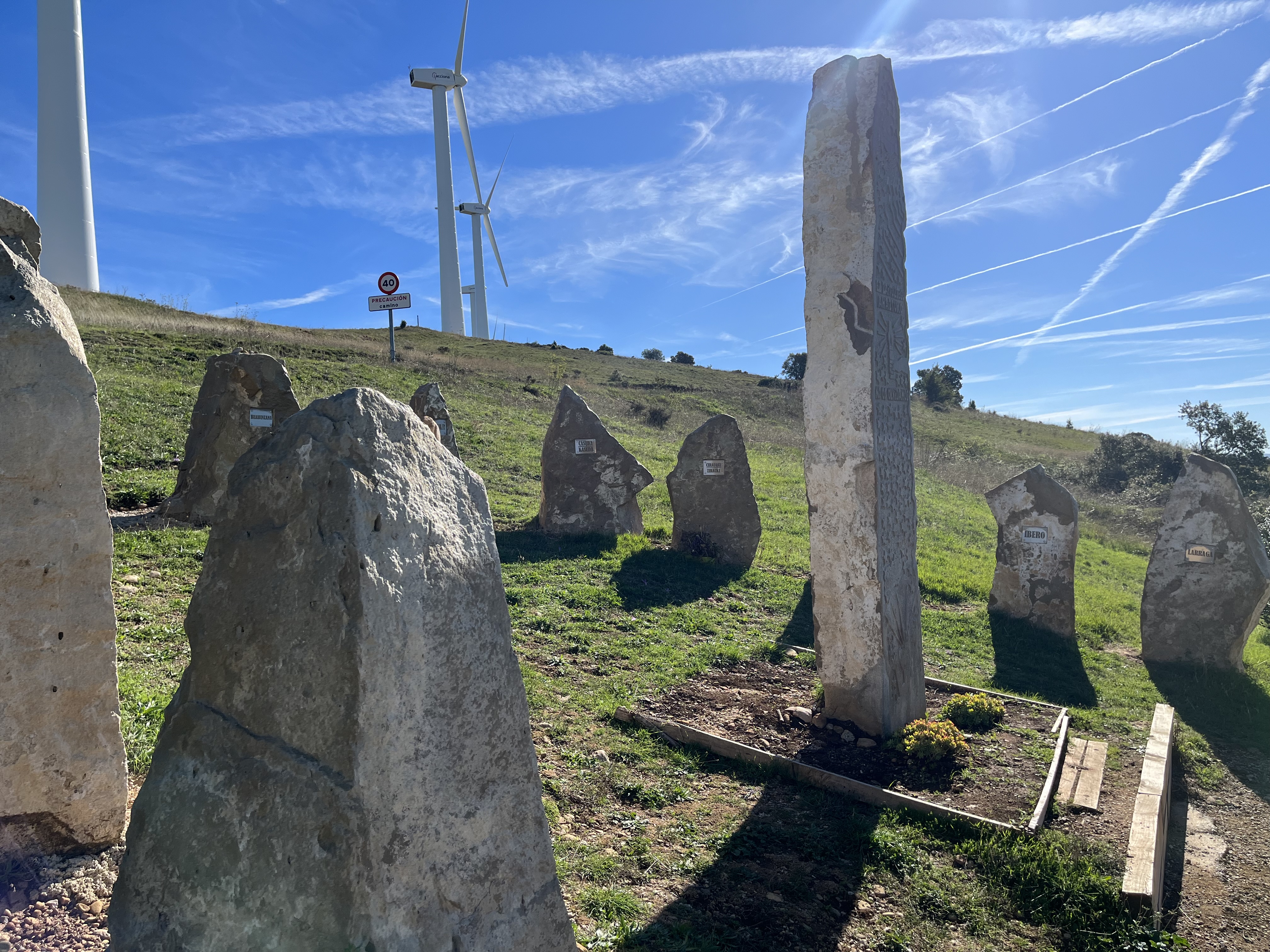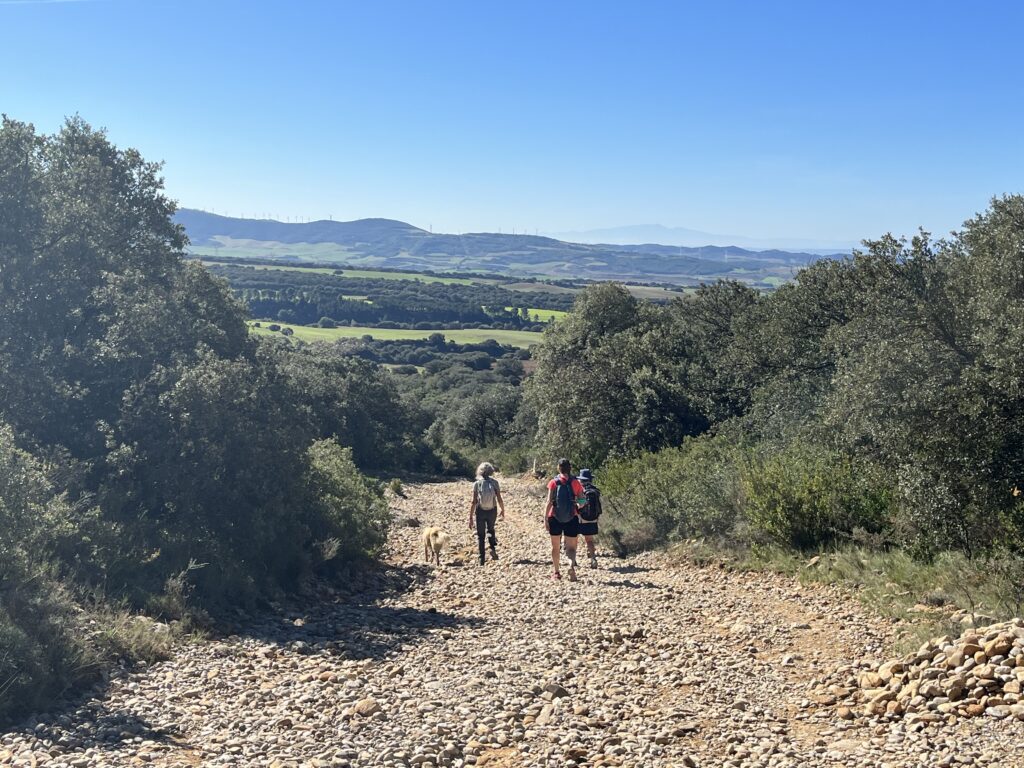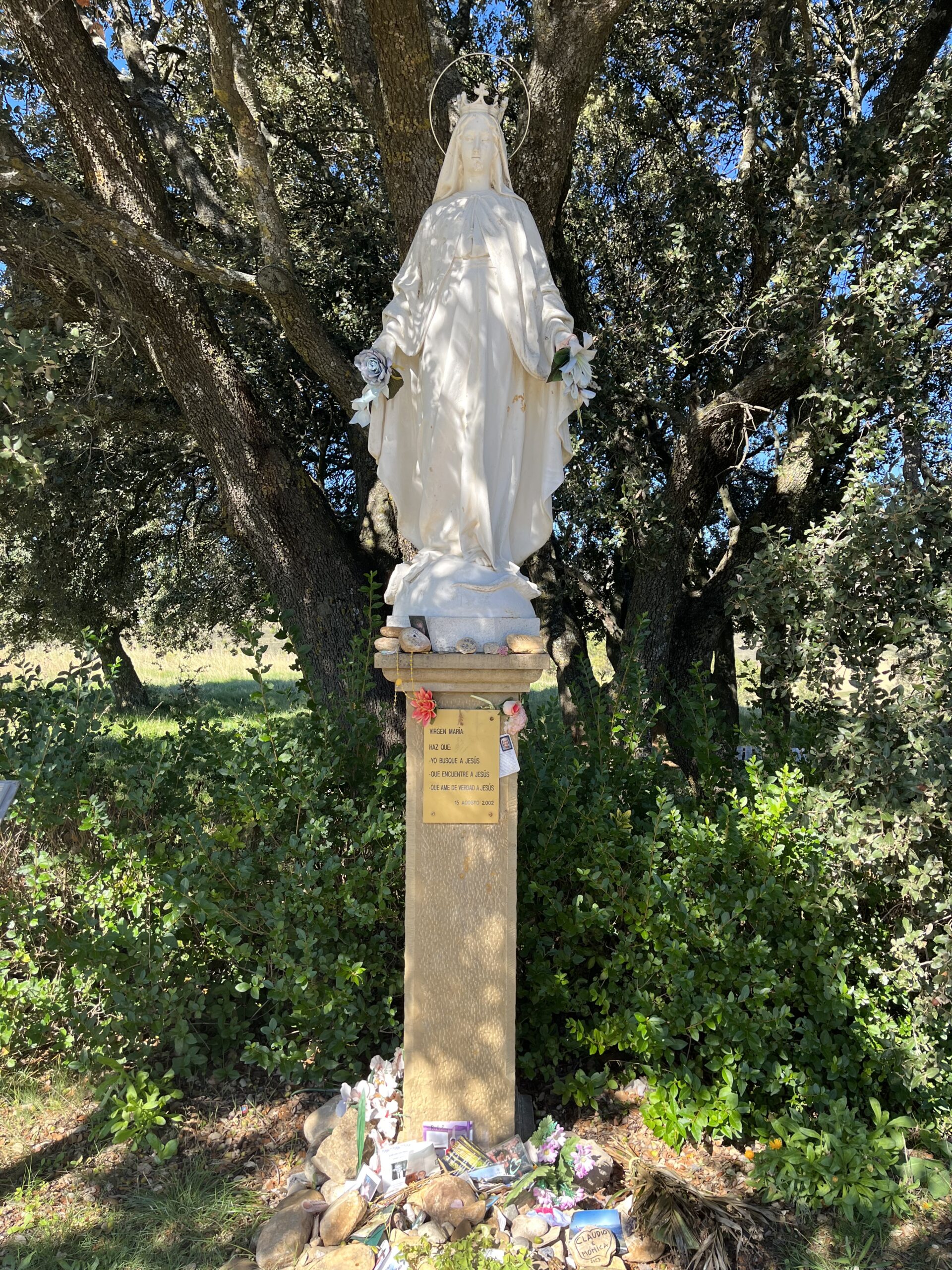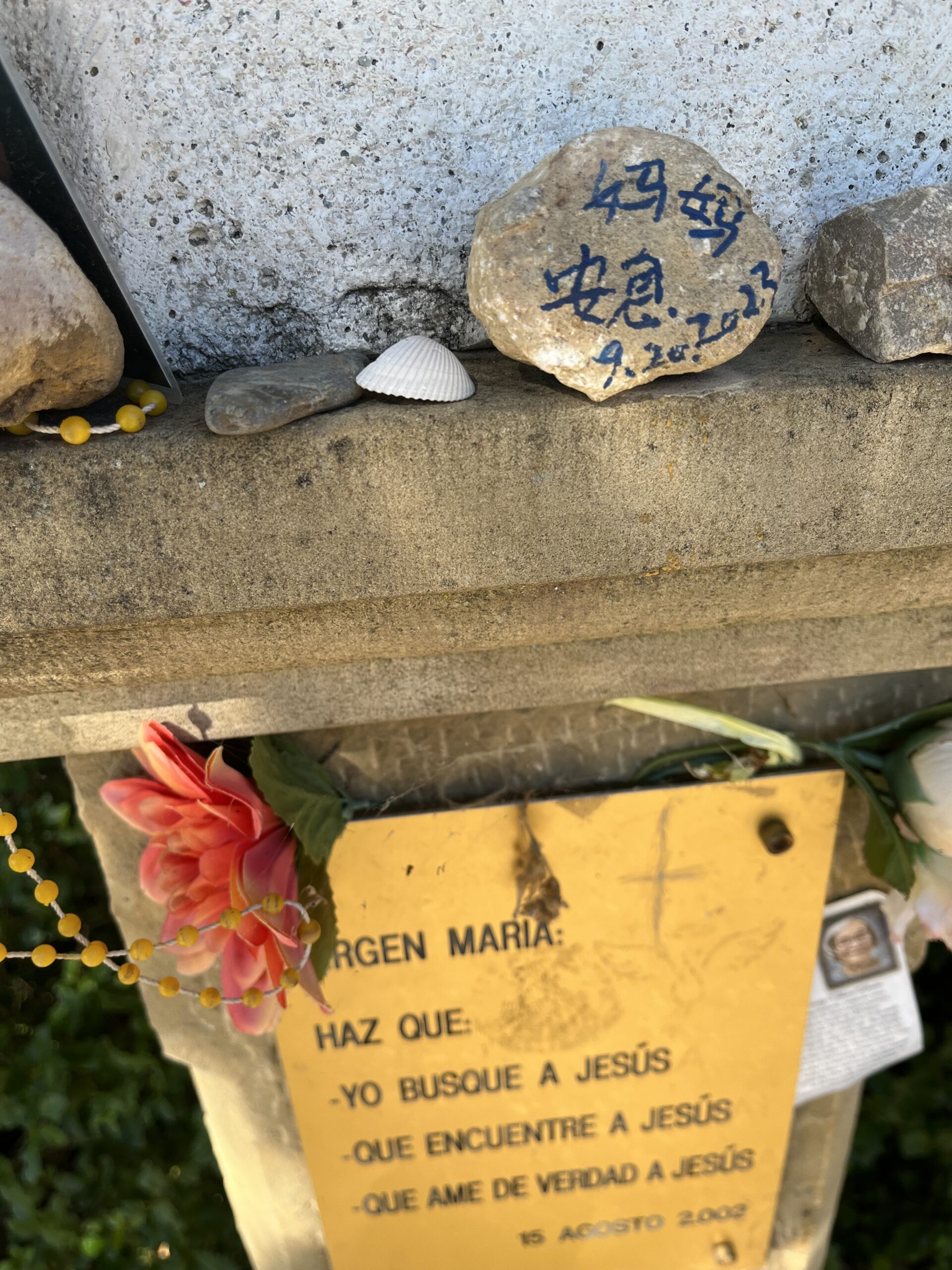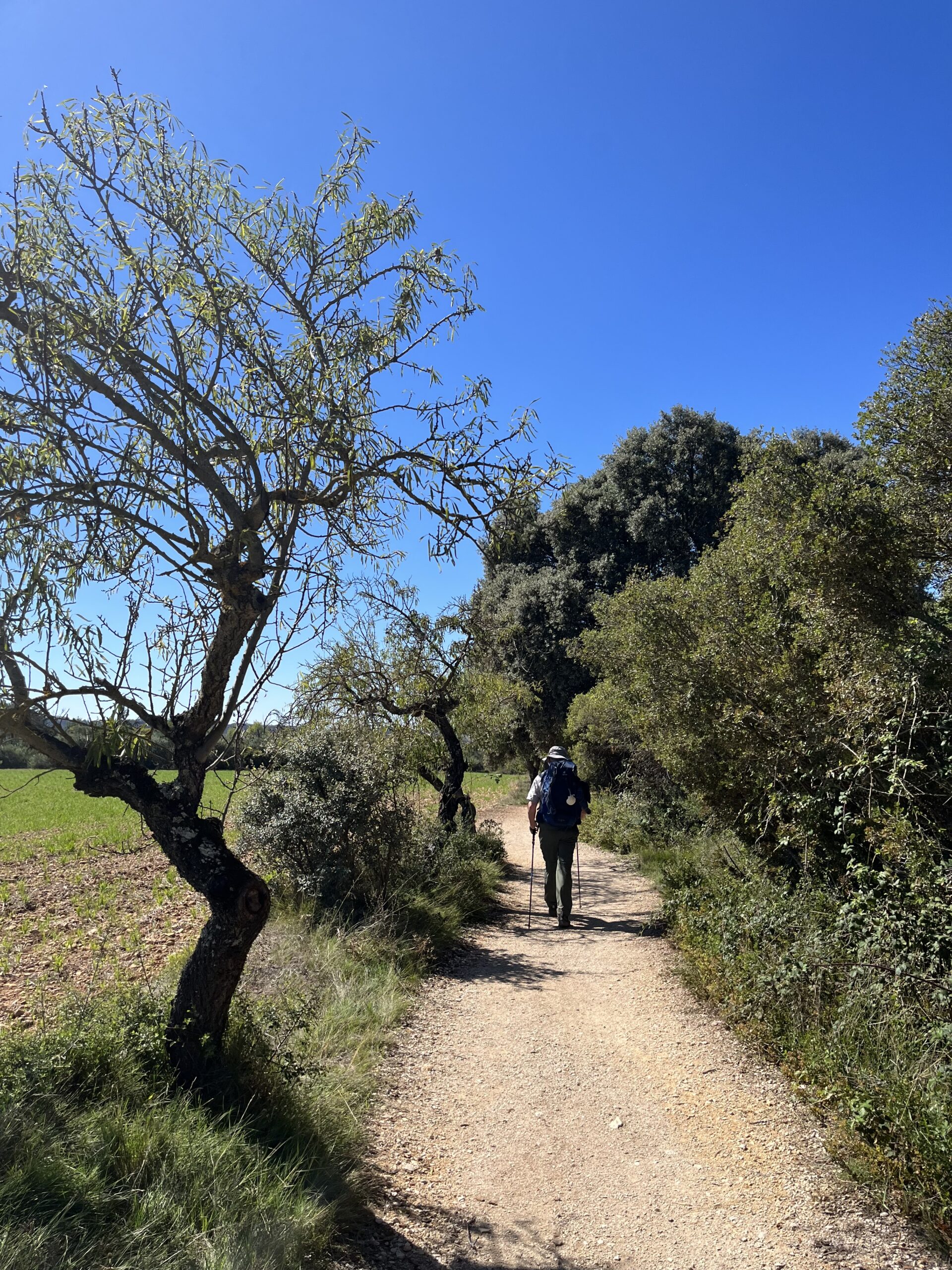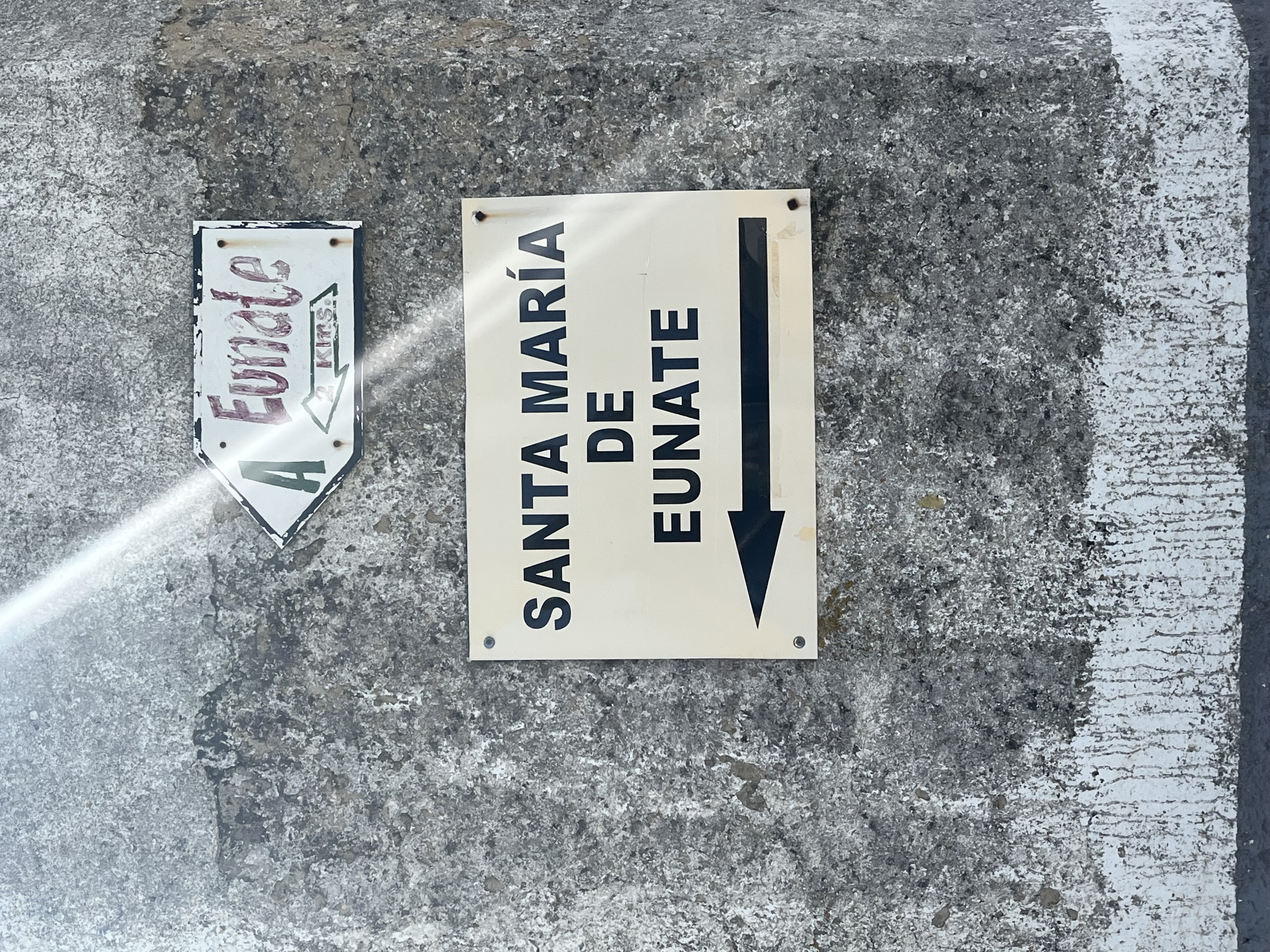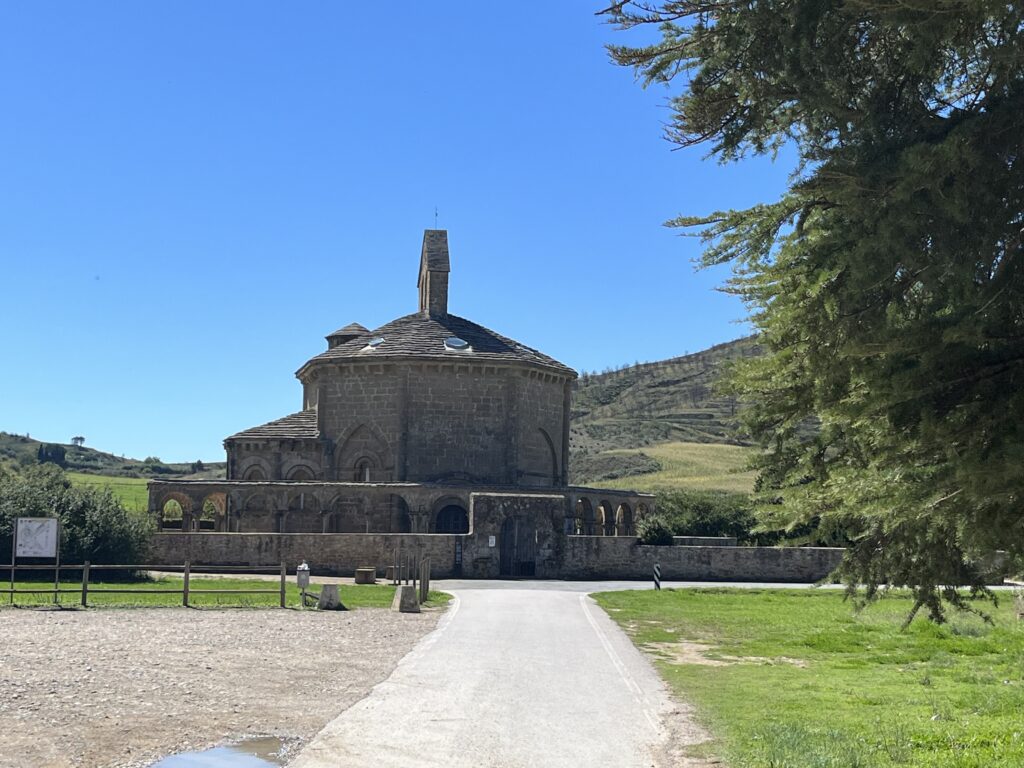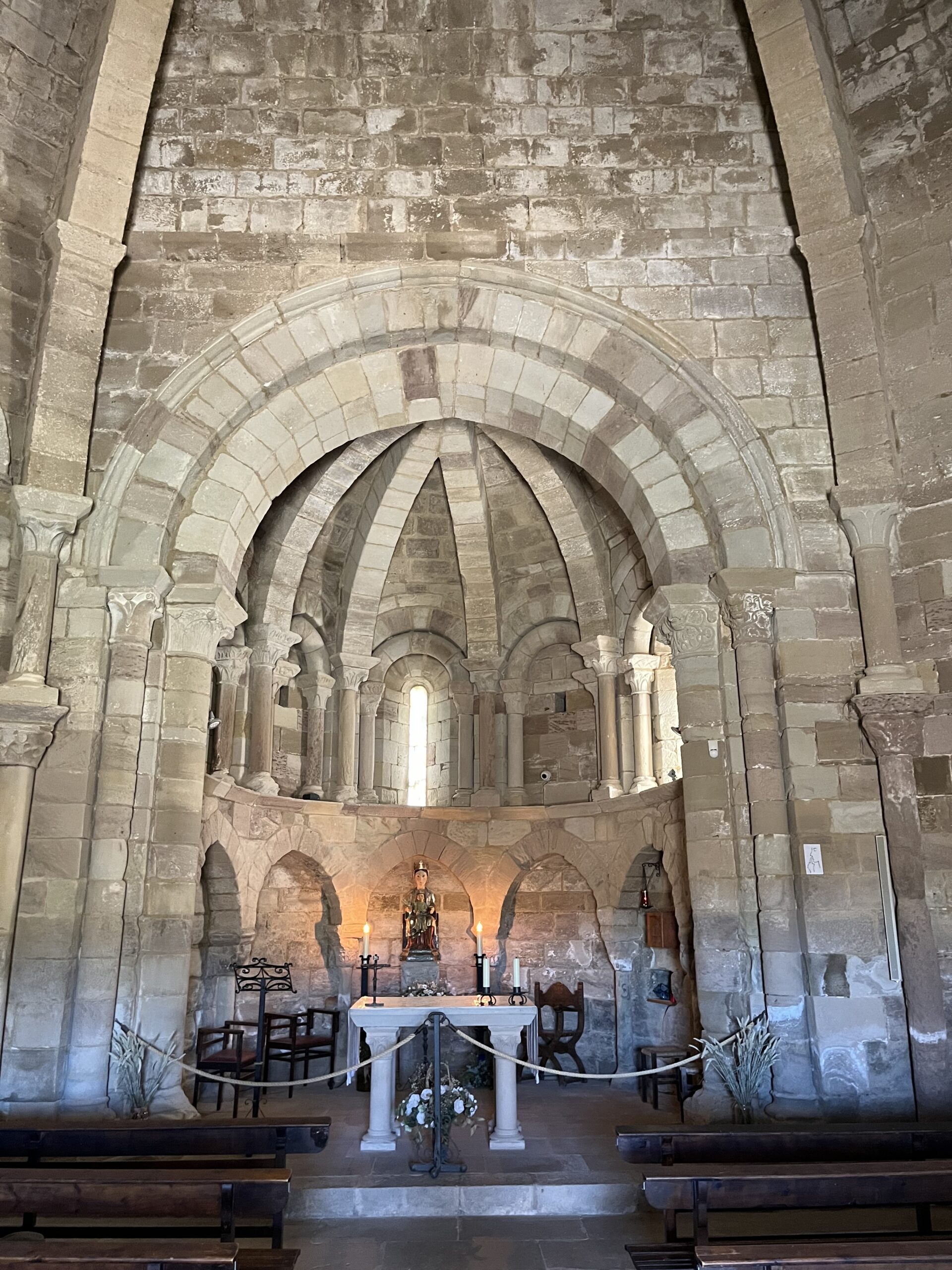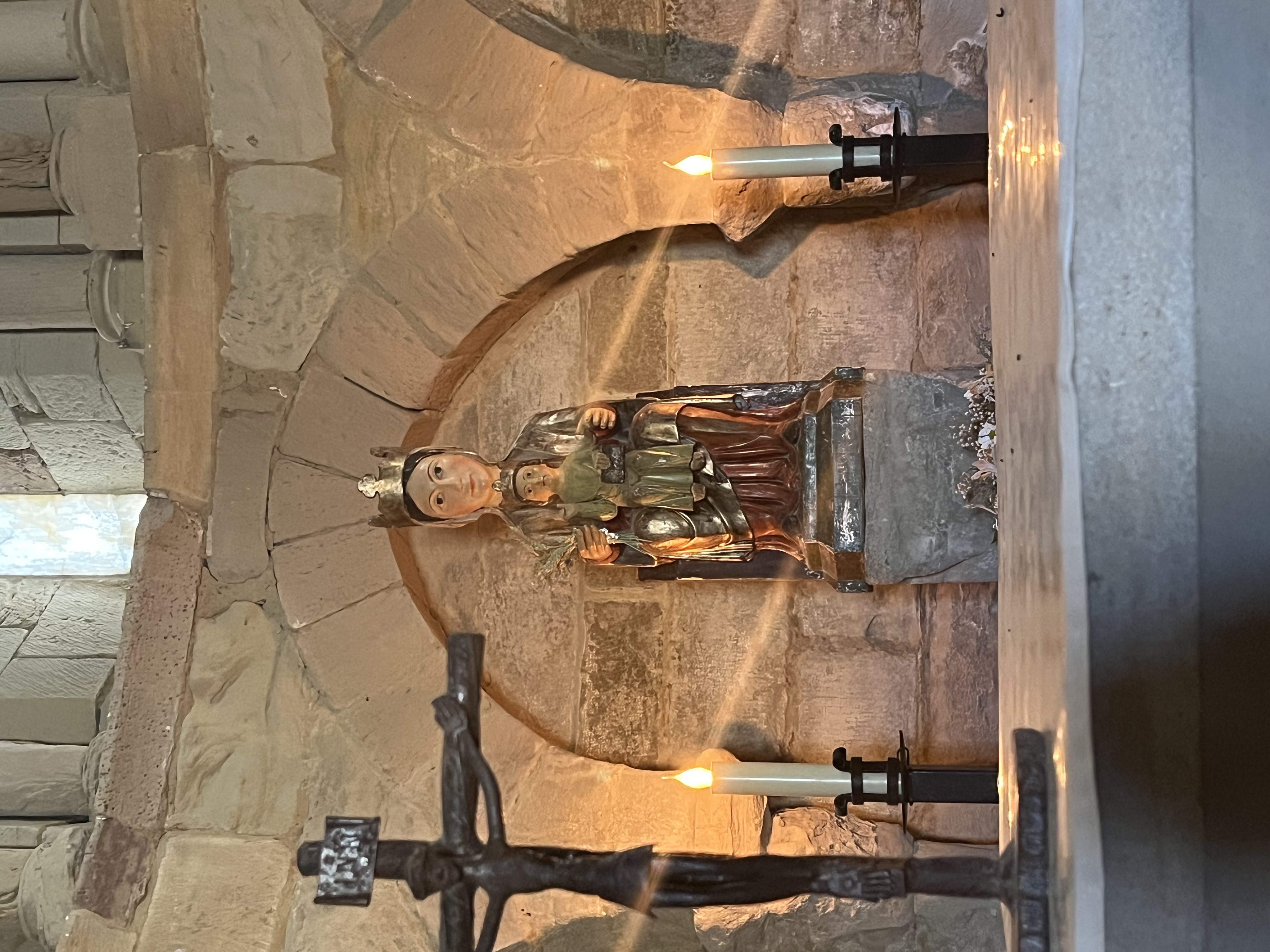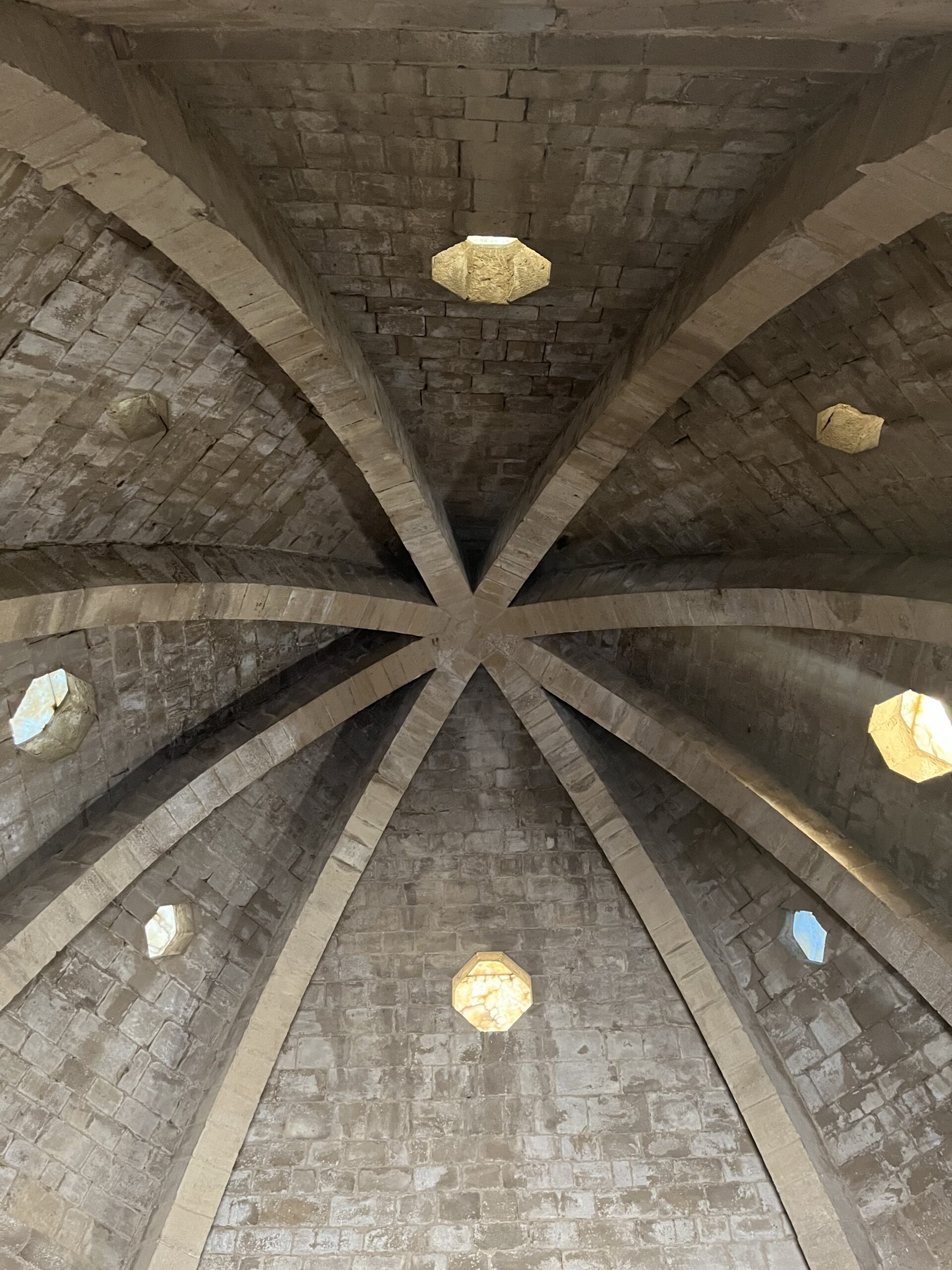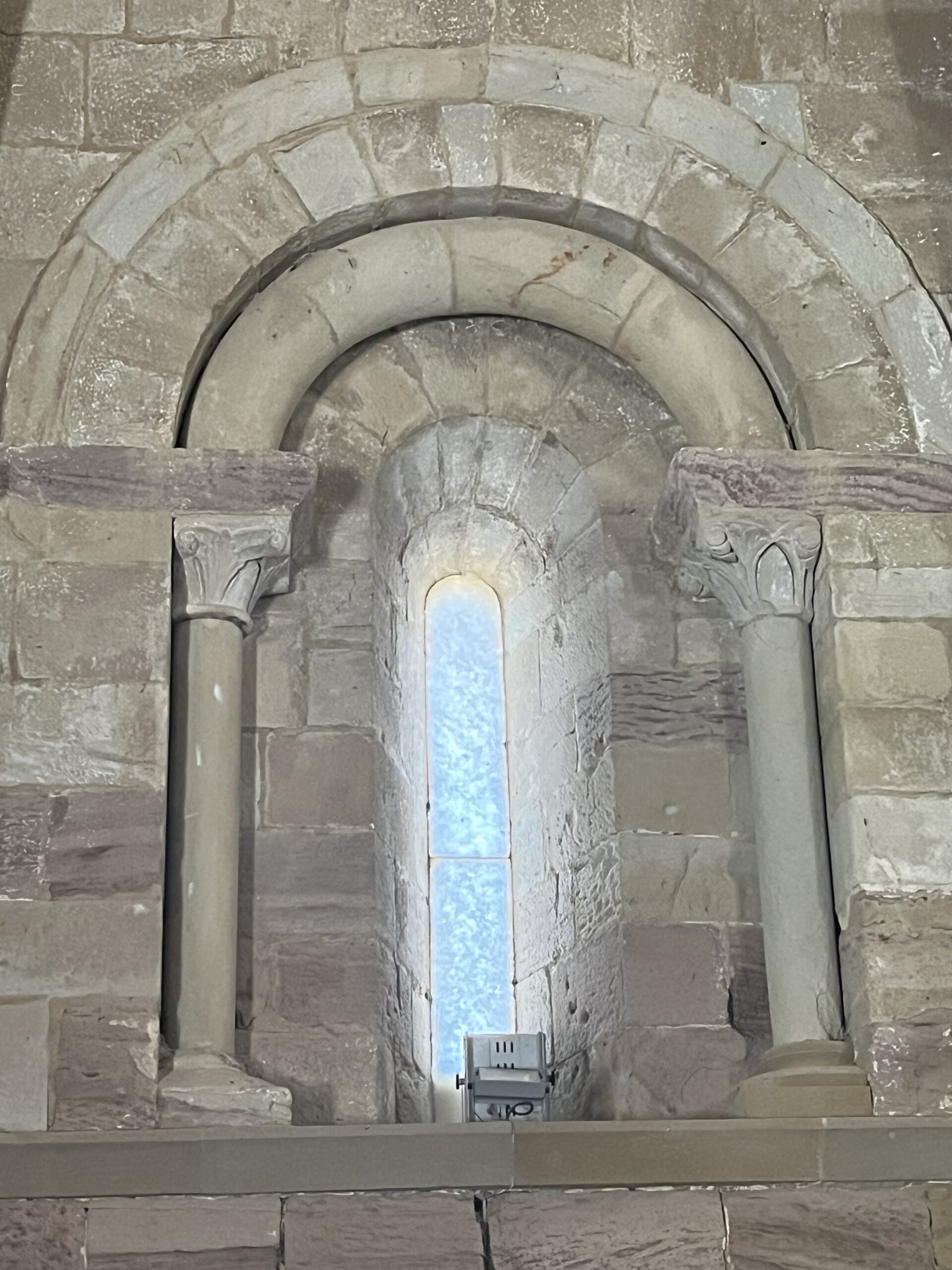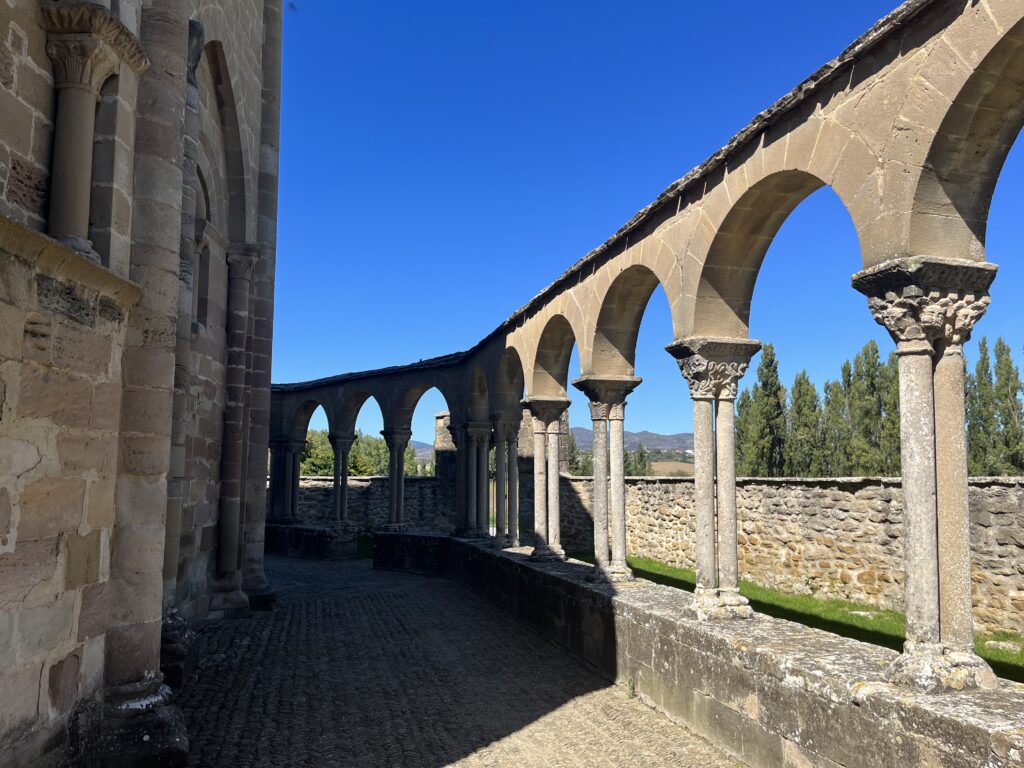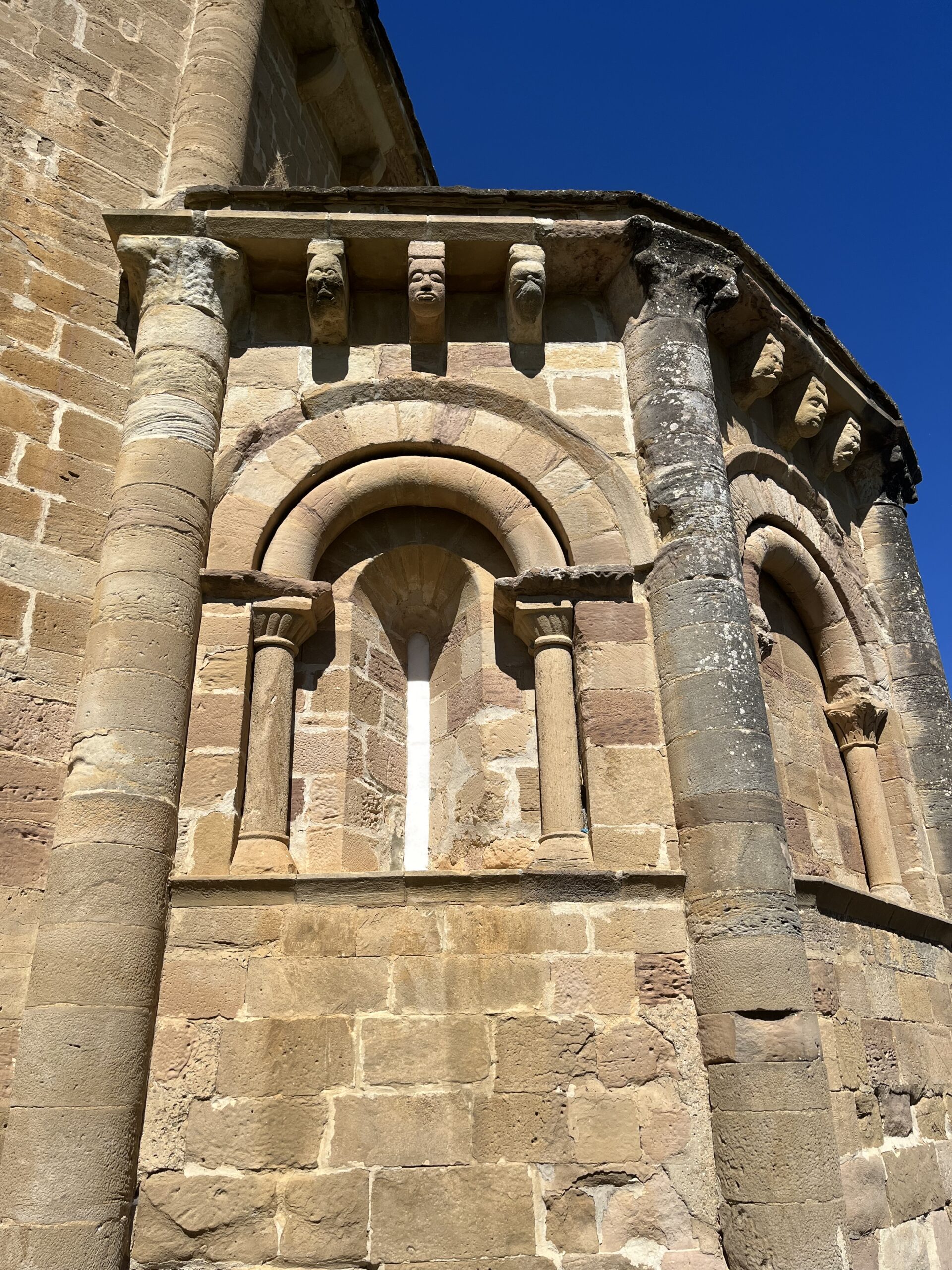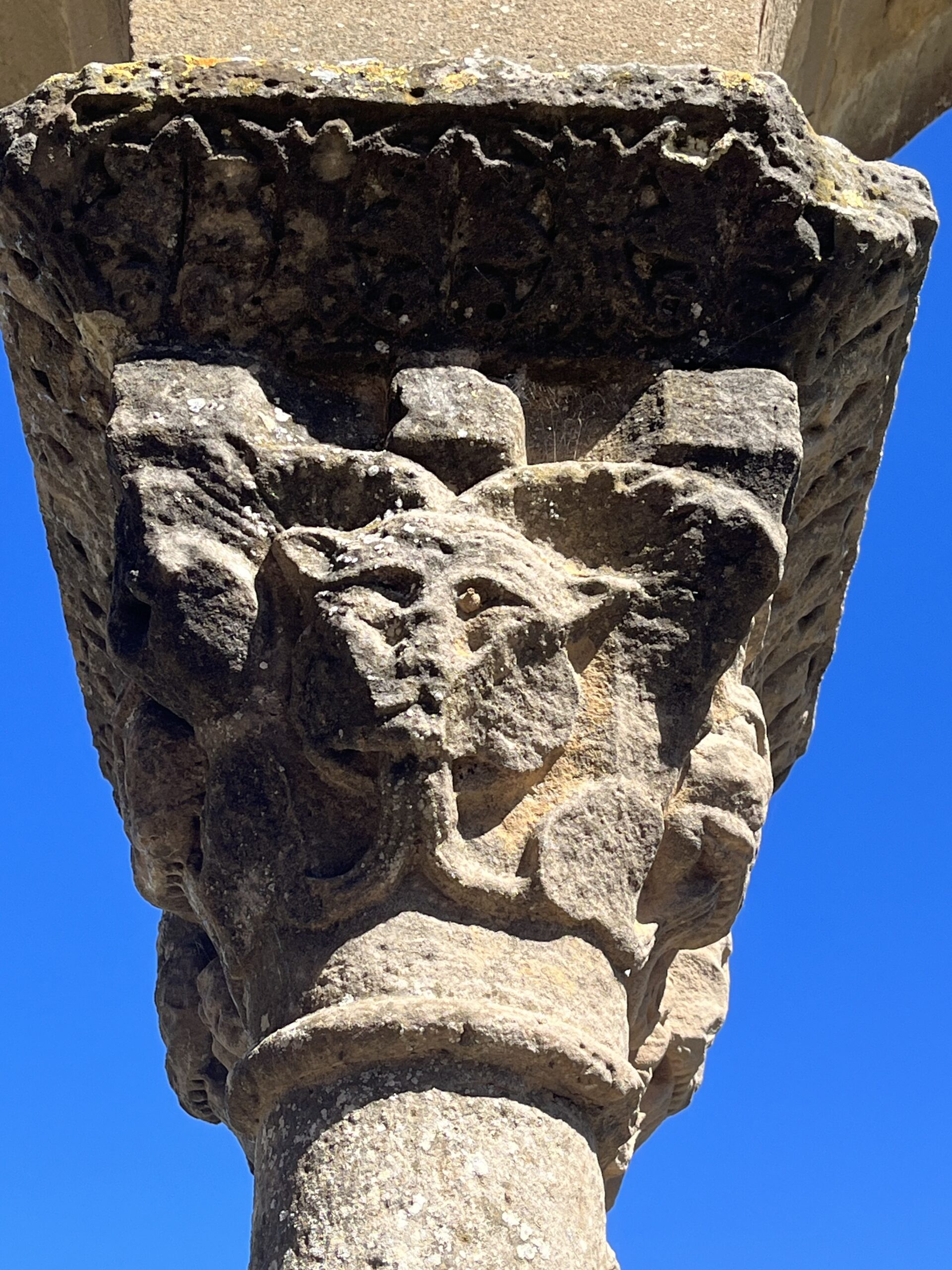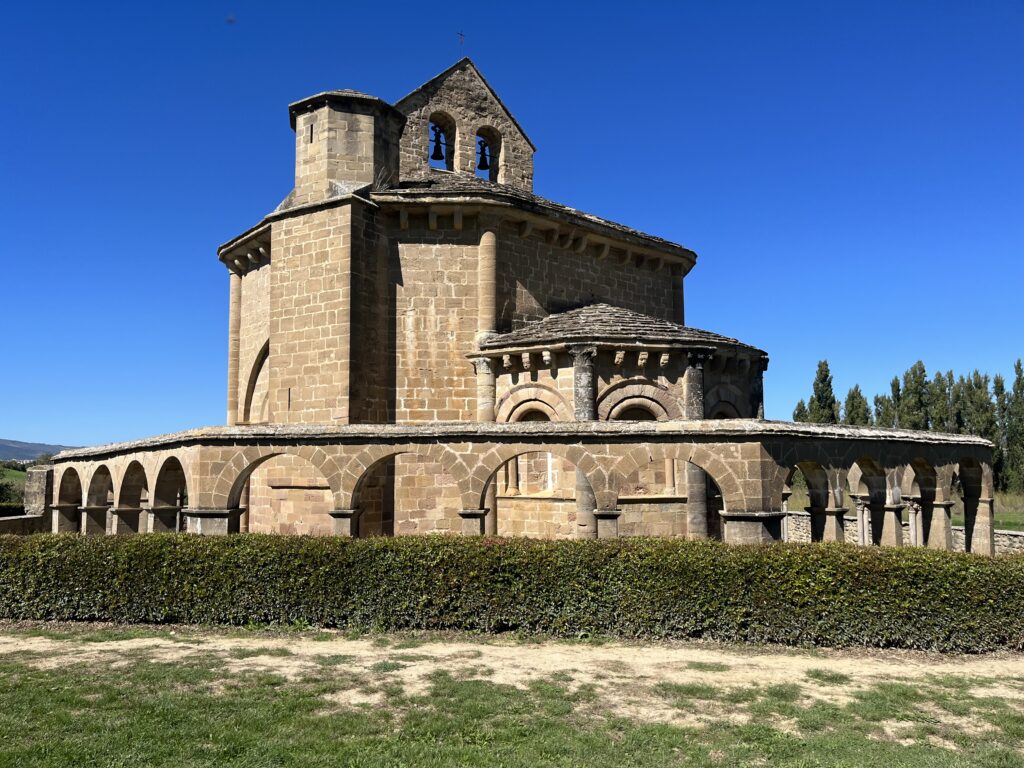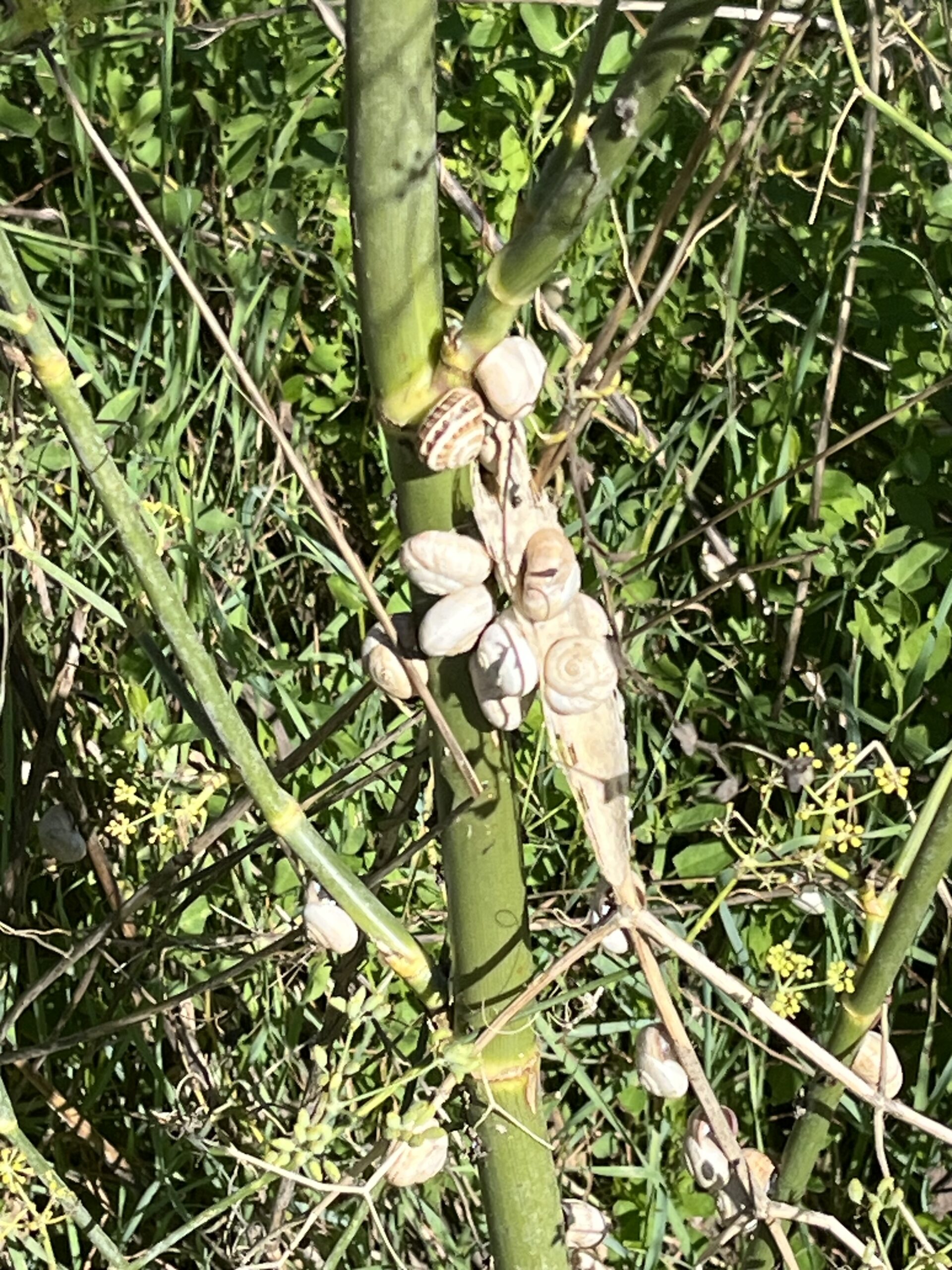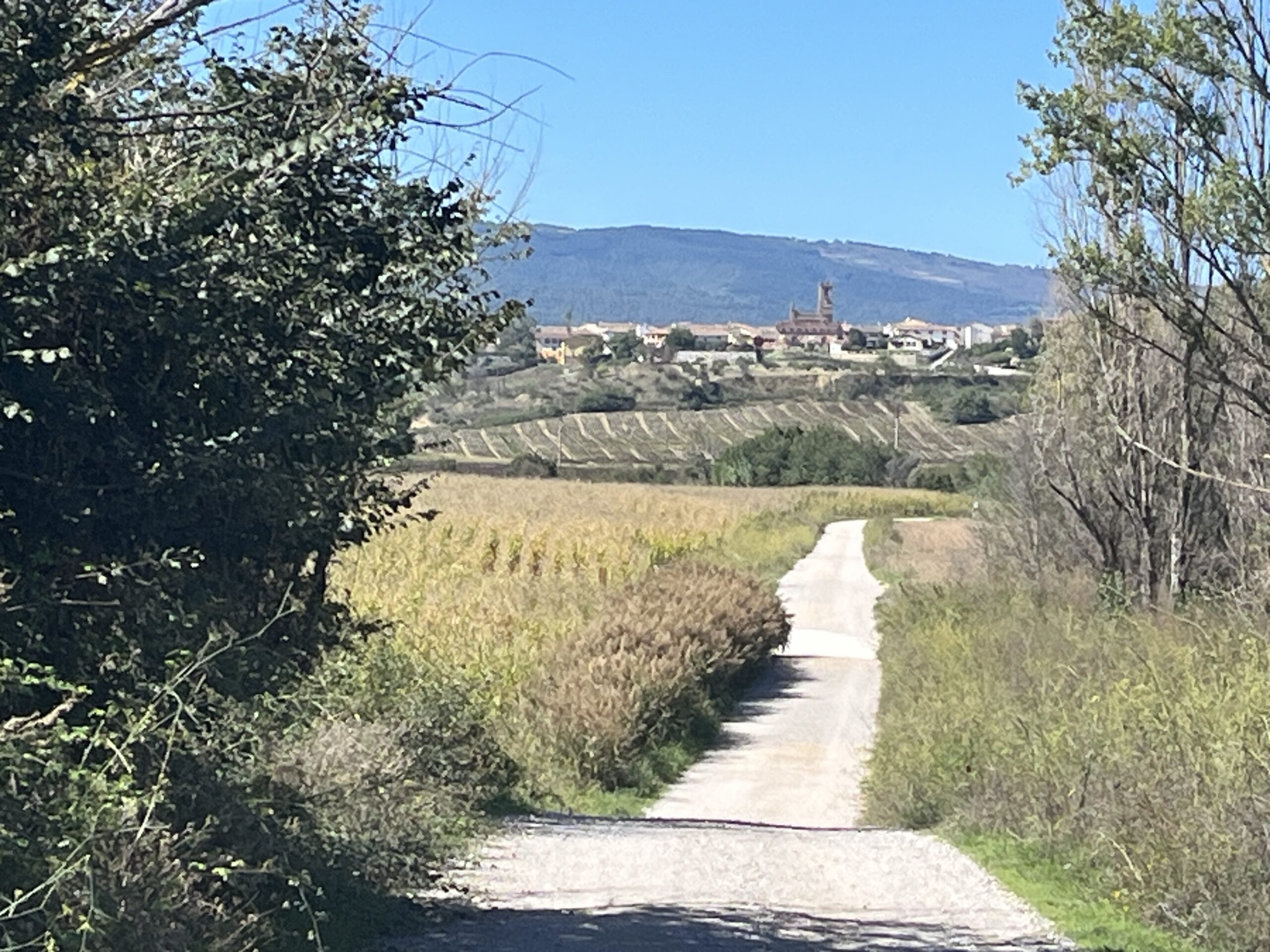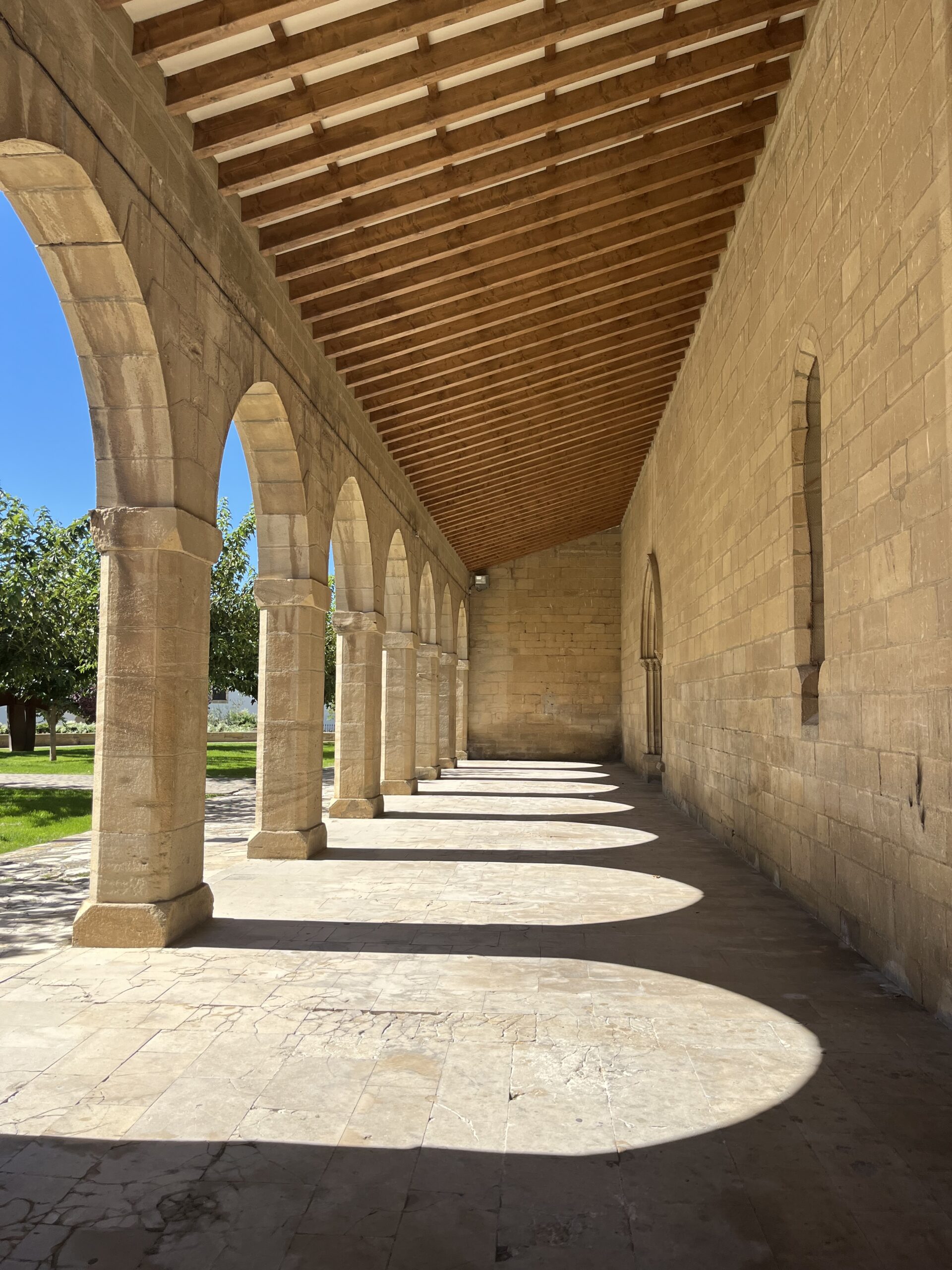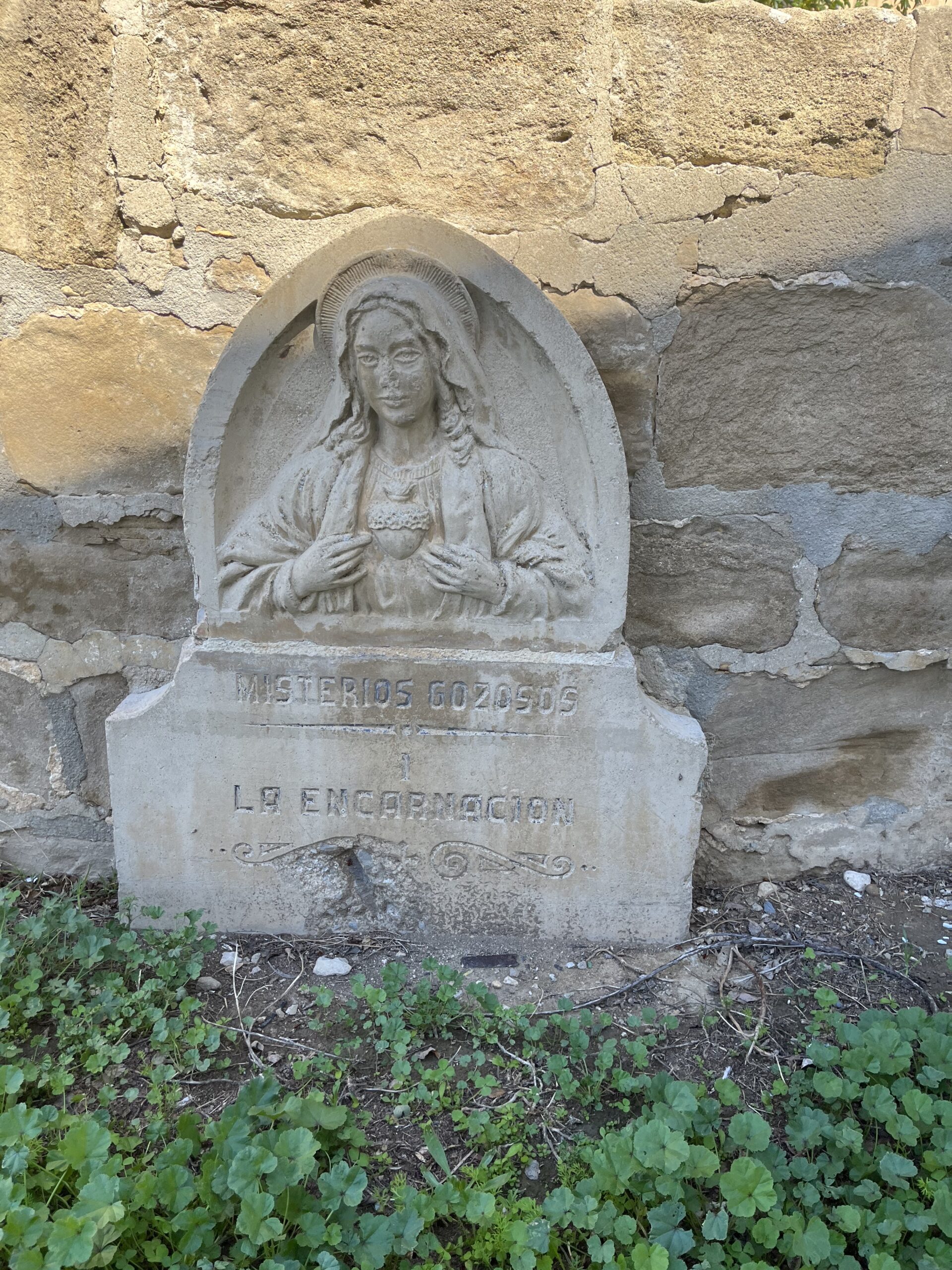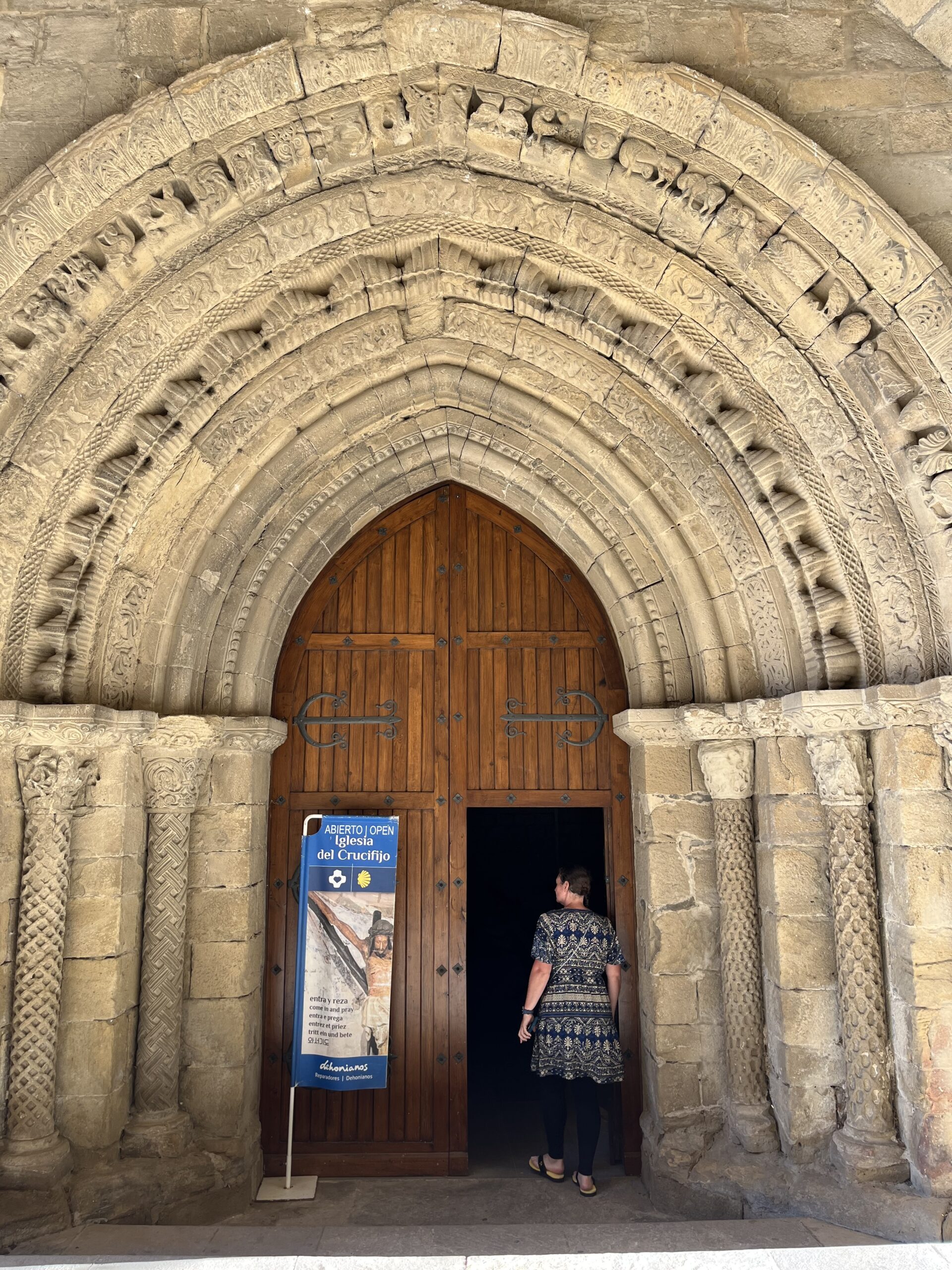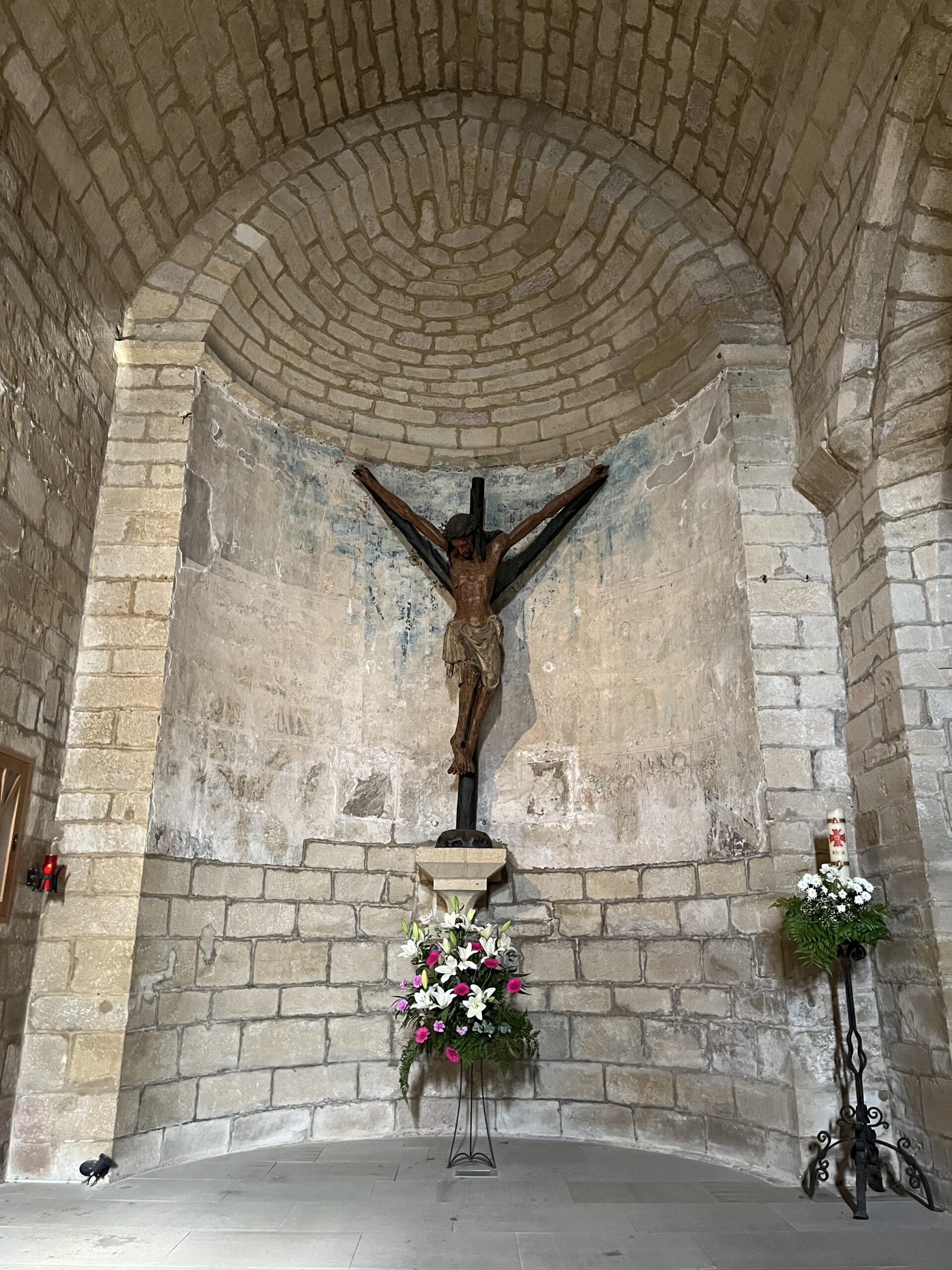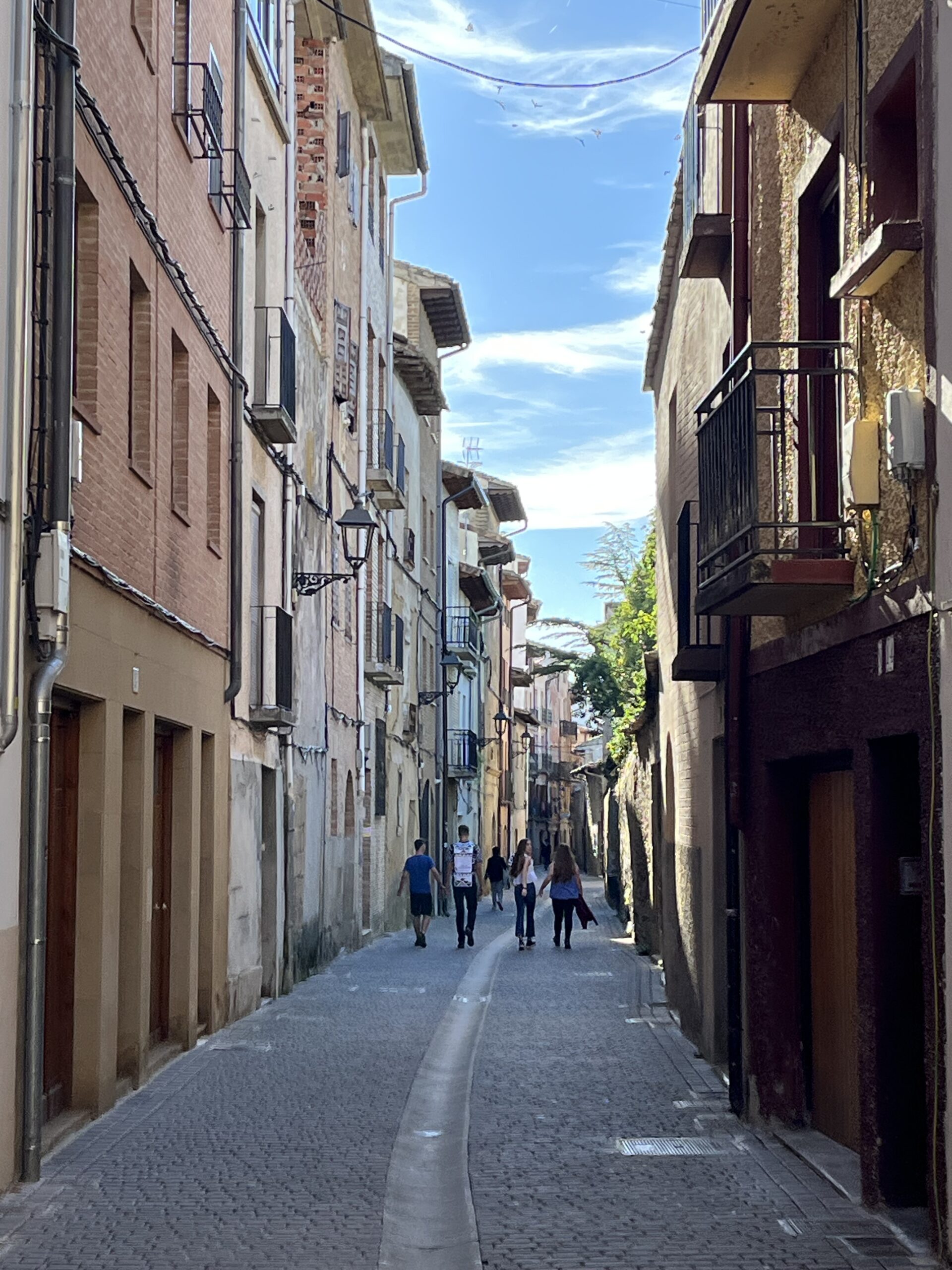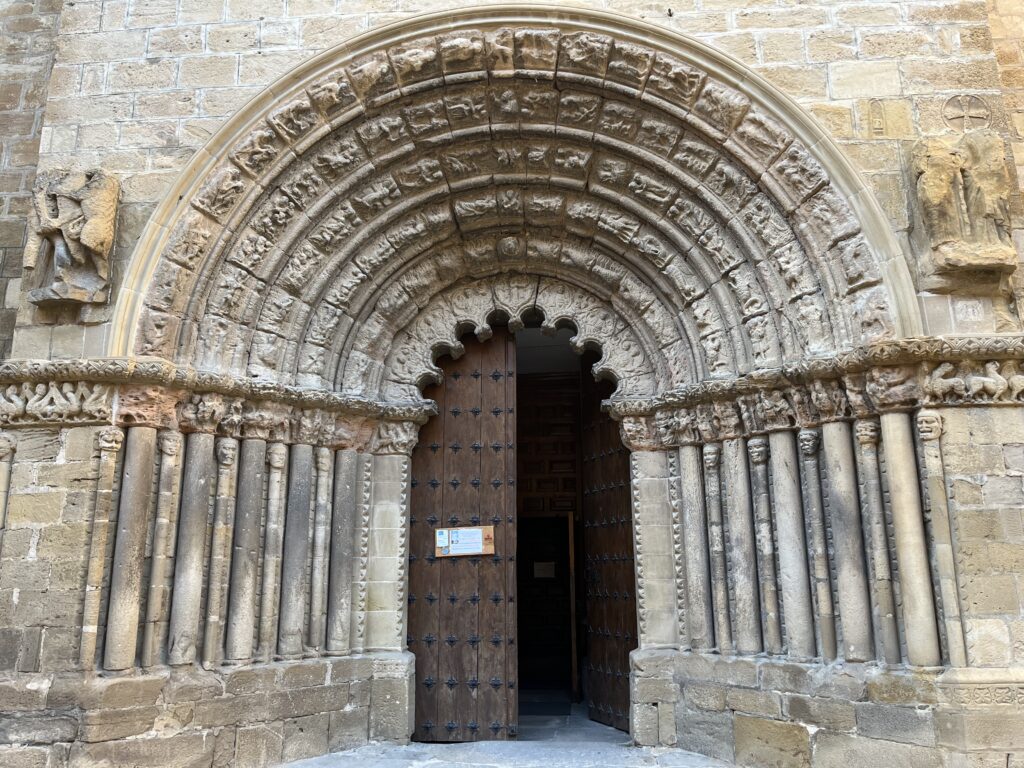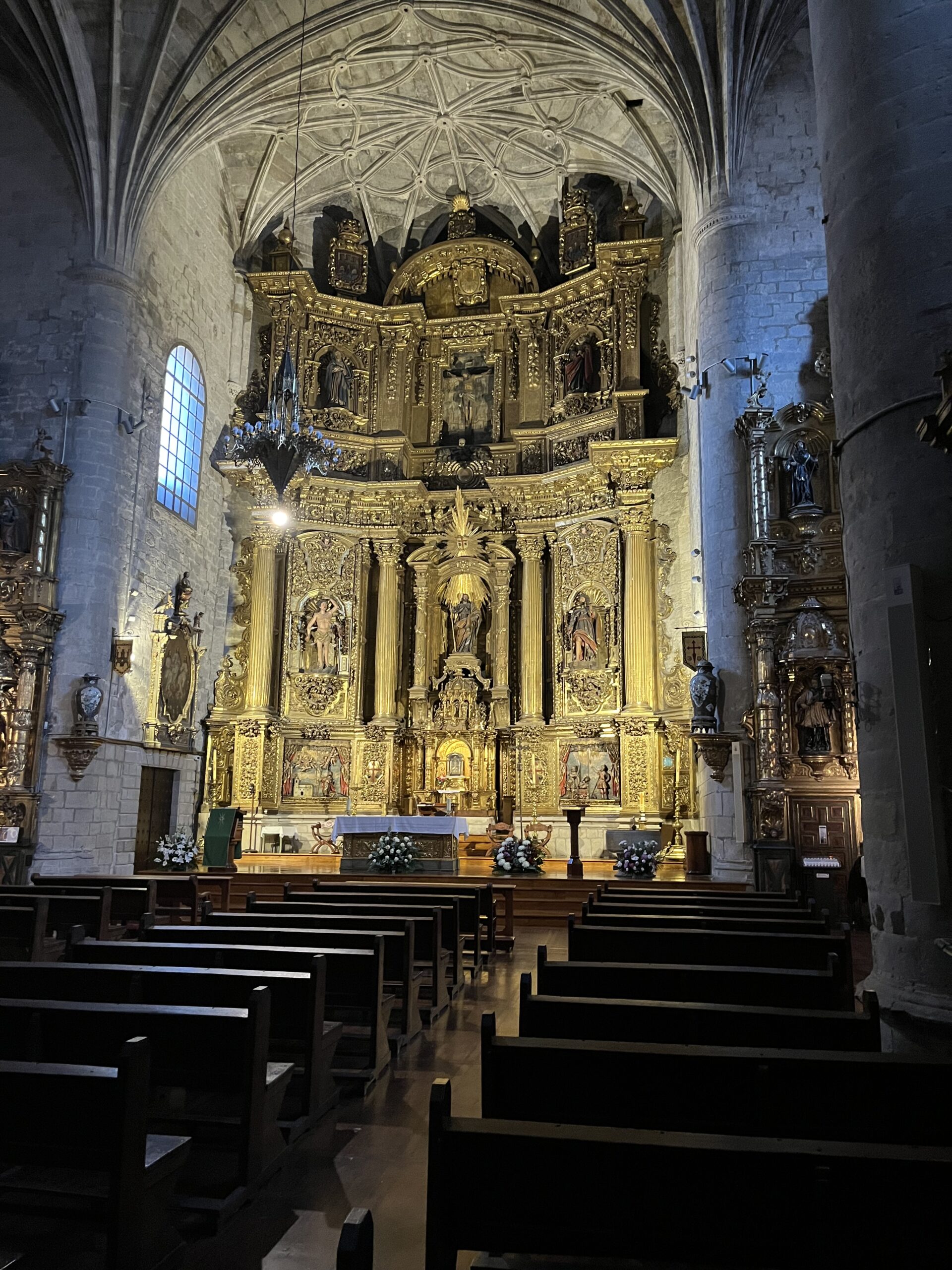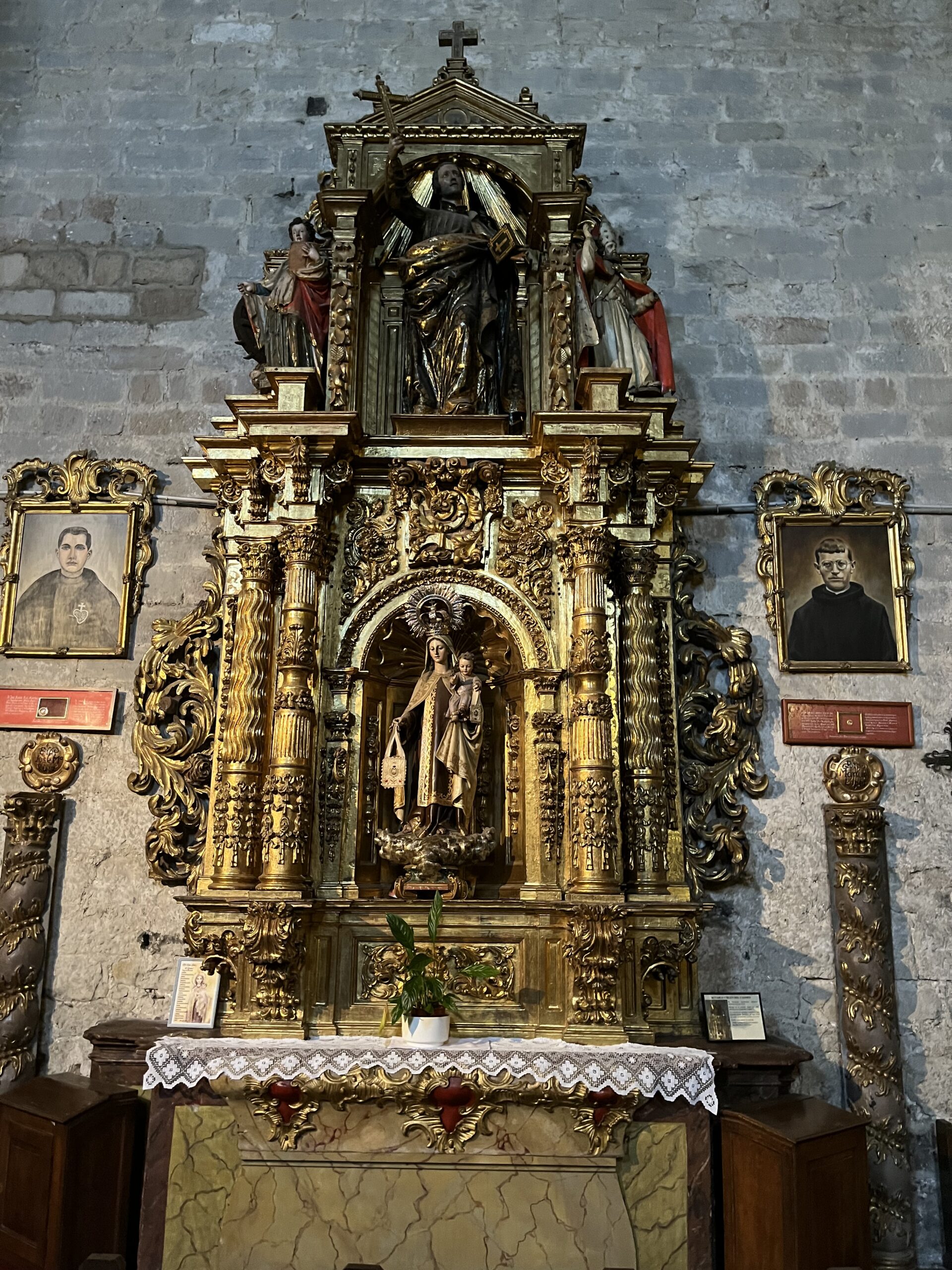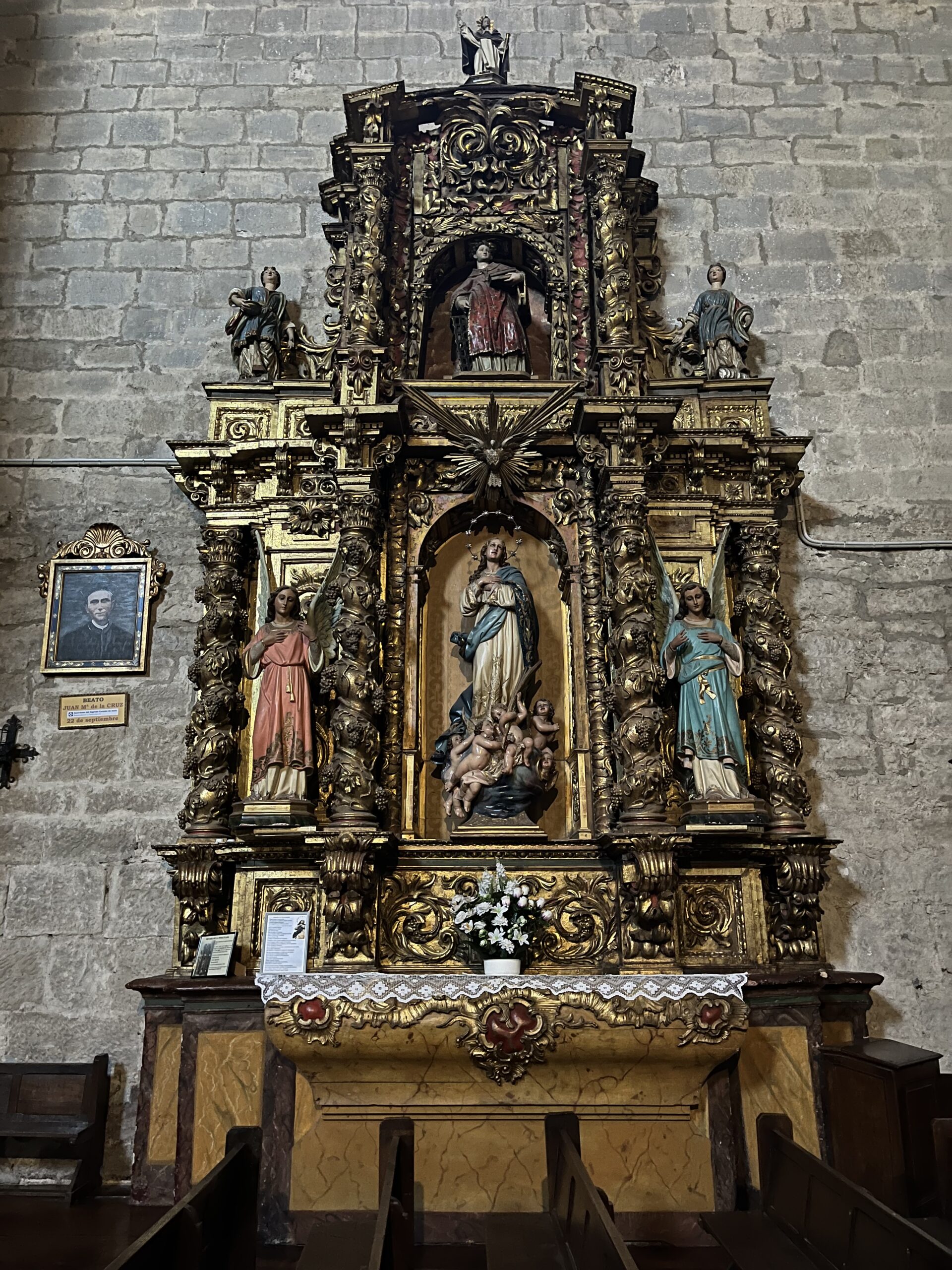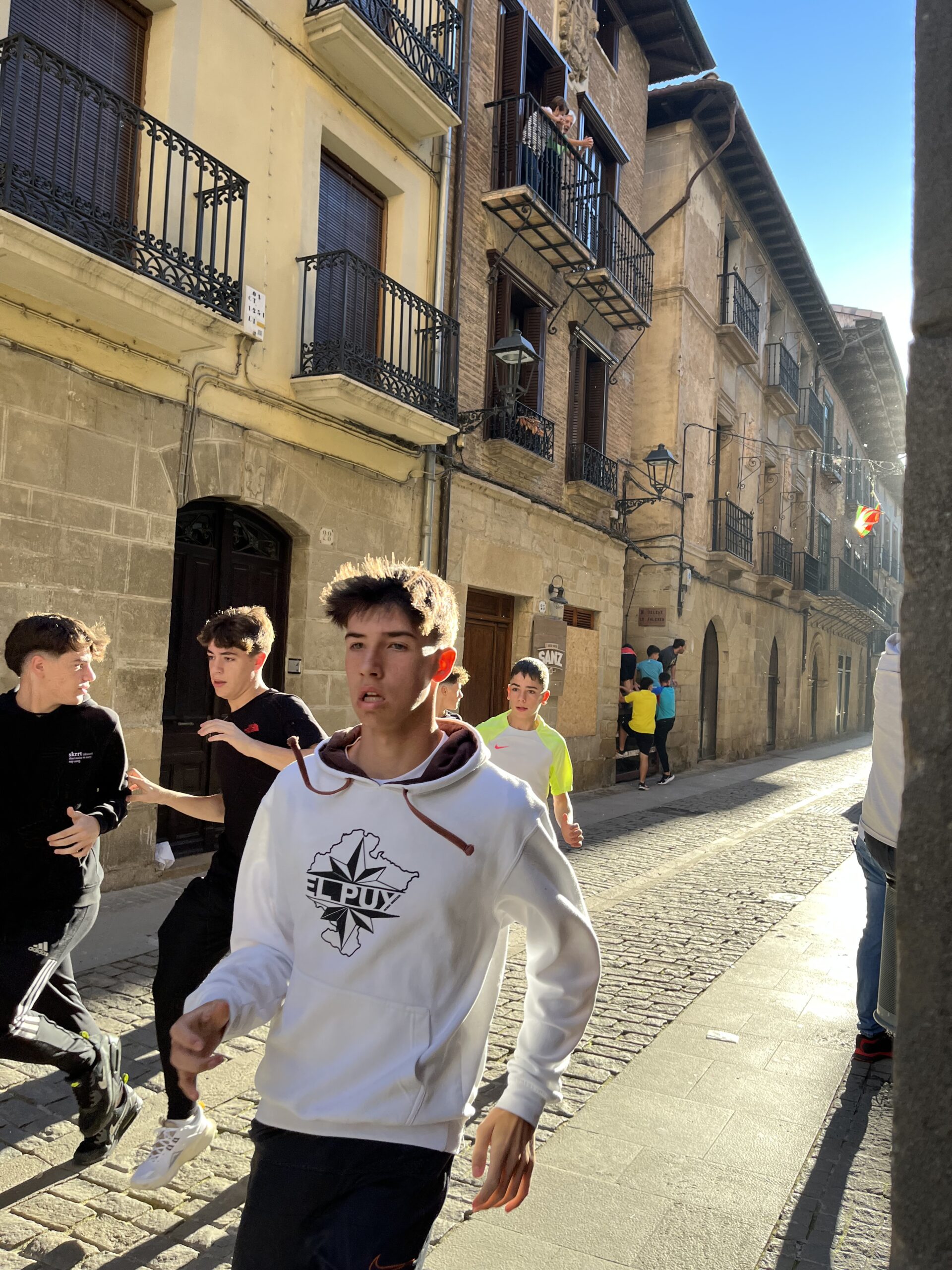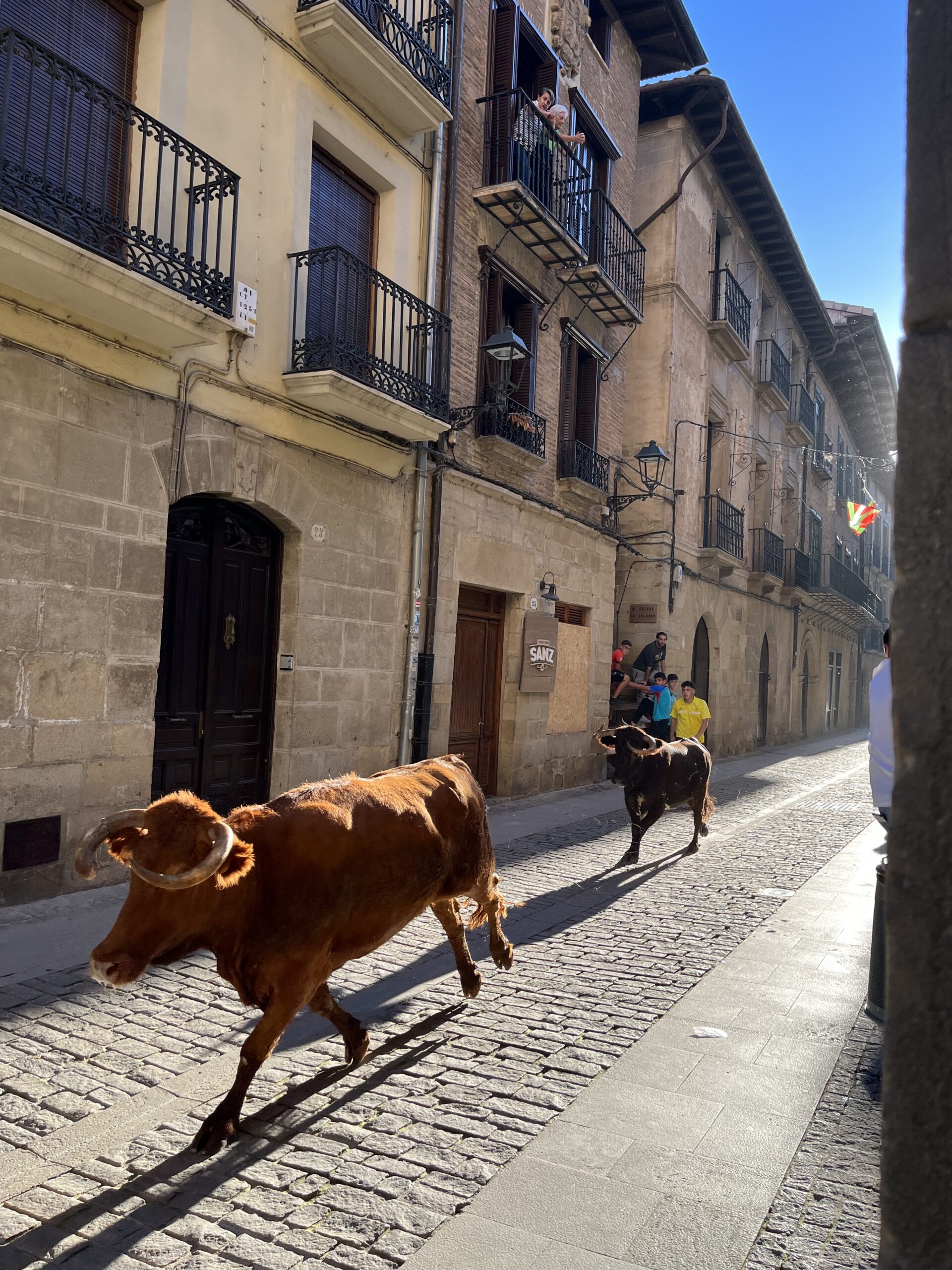Via Podiensis: Alto de Perdón, Eunate, Puente la Reina
There were many churches I wanted to visit in Pamplona, including the 13th century church of San Cernín, which has a Baroque chapel containing the miraculous statue of la Virgen del Camino. Unfortunately, most all of them were closed, probably due to the chaos intendant on the fiesta. Perhaps next time.
How bad were the crowds? We briefly joined a parade through the streets (complete with banners and bands) because it seemed like the fastest way to get where we were going.
Slept like a rock. I’m sure the fiesta lasted all night, but once the albergue doors were closed, the thick stone walls shut out the sounds of revelry and music.
Many of us were out the door at 7 and looking for breakfast. There were still little groups of revelers in the streets. Tara spotted a place for breakfast just off the Camino. It was full of locals – we were the only pilgrims there. I had my traditional Camino breakfast of café con leche and Napoletana.
It was urban walking out of the old city, and the further away from the city center we were, the fewer people we saw. We walked along a major street, and then through a lovely city park with trees arching over the path. This is the first time I haven’t gotten lost walking out of Pamplona. It’s a lot easier to follow the signs embedded in the sidewalks when you’re the only ones moving around.
The Camino turned into a run through a high-rise gauntlet, as apartment blocks loomed around us.
The urban faded slowly to a more rural landscape, unlike the abrupt change from one to another is that I experienced in previous years.
We reached Cizur Menor about 8:35. It’s a cute little suburb, and it was probably a proper village once. We tried to visit the old Hospitalar Church there, but it was locked of course. This is Spain after all. Prayed outside the doors anyway. That’ll show them.
At about 8:45 AM, we finally left the sidewalk we’ve been on since Pamplona. It was gravel at first, but it soon transitioned into roadwalking.
There’s a lot more suburbia here than I remember. I don’t know if that is me romanticizing my memories, or if there’s actually been a lot of urban sprawl in the past decade.
Just before nine, it was back to gravel and finally out into the fields. Soon, we begin the long climb, shallow and intermittent at first, but gradually steeper. For a while, we were under tree cover.
And then back out on a wide gravel road up through the fields.
We arrived at the village of Zariquiegui about 10 AM. Amazingly, the 13th century church San Andrés was open. It was extensively rebuilt in 16th century, and the retablo is pretty impressive for such a small church. Some of the statuary is in a charming, almost folk style. An almost primitive statue of Our Lady of the Rosary has been recently re-gilded.
I prayed for the intentions of the Camino here, and then moved through the town and on up the hill.
Much of today has been unfamiliar to me, due to some combination of my faulty memory, rerouting, improvements to the Camino, and increased urban sprawl. This section was no exception to the changes.
In place of the steep, deeply washed out, and narrow dirt path I climbed up the hill in 2013, I now walked a broad, evenly graded gravel road that snaked its way to the top of the Alto de Perdón.
I was being regularly passed by speeding bicycles.
Even when it became much steeper, it was still a very pretty gravel path up the side of the hill – a hill where pilgrims once gained a partial indulgence by simply climbing to the top.
For a brief while, the path narrowed to perhaps a meter and a half wide, which is still roughly three times its greatest width when first I climbed it.
I do not want to say that it was easy – the hill is still steep after all, that hasn’t changed – but it was much less difficult than the first time I climbed it. On my way up, I met a couple of local joggers on their way down.
Finally, at the shallow section about halfway from the top, it narrowed down to the width that I remembered. But by this point, it was nothing but shallow switchbacks. There were definitely some muddy sections but nothing like past years.
Nevertheless, I was a bit of a sweaty mess when I finally crested the top at about 10:45 AM. The obligatory photos of the pilgrim statues at the top were taken, of course, as well as a photo of Pamplona in the valley on one side of the ridge and the valley we were heading to on the other.
There’s also a memorial there, a circle of stones, commemorating locals who were murdered by the Spanish fascists during the Civil War. I stood and prayed there a while for the repose of their souls. This monument is relatively new, erected in 2017, so I had not seen it before.
Then, the long climb down into the next valley.
It was more of a rock slide than a path: steep, covered in loose stones, and very slippery. It was kind of a nerve-racking descent.
I’m slower on the downhills than I am on the uphills, generally, but even so it was almost 11:40 AM before I made it to the relatively undulating road at the bottom. This was pleasant enough dirt through newly tilled fields on both sides. We were still high enough that you could see the valley spread out before us, each little town and village a distinct entity. It was almost like looking at a map rather than the land itself.
Eventually, they were trees on the left-hand side, which provided so much needed shade.
About noon, I caught up with Tara, and we soon came to the statue of the Virgin of Irunbidea. the sign below the statue reads:
The request of the Virgin of Uterga:
May you search for the Lord,
May you find Him,
May you adore
and love Him.15 August 2002
The statue was given to the village by a pilgrim who was worn and weary and felt that he just couldn’t go on. A six year old girl passed by and he asked her name. “Maria”, she replied. His faith and his strength were restored at the sound of her name, and he went on to finish his pilgrimage. He later gave the statue to the village.
I left Karen’s second shell here.
We popped into the church in the village of Uterga to discover that we had walked into the middle of Sunday Mass. I offered a quick prayer and we left. It didn’t seem right to stay, given the circumstance.
We had lunch in the village with a lovely Australian couple and left about 12:40.
We arrived in Muruzábal at about 1:10, and the local parish church was locked.
We made the decision that we were going to push on to the detour to Eunate.
This was roadwalking, and then gravel. At every possible intersection or fork, there was a sign.
The Church of Santa María de Eunate is located in a field more than two kilometers from the nearest village. It was built and maintained by a sacred brotherhood whose roots go back at least to the 12th century, and barring one century-long interruption, continues to this day.
When I first visited here a decade ago, it felt like holy ground. It still does. I can’t explain the serenity that seems to exude from these walls, and I can’t explain my fascination with this particular statue of the Virgin and the Christ Child.
The word “eunate” is from the Basque, and it means “a hundred doors”. It said to be a reference to the doors of the church and the arches surrounding it, where the brotherhood would pray the rosary, with one Ave at every archway or doorway.
The church itself is octagonal, like many baptismal fonts, and for the same reason.
At just a few moments after 2 PM, the guardian of the church announced that it was closing, and we had to leave.
It was a relatively short, those steep uphill through farm country into the town of Obanos about 2:40 PM. Unfortunately, the church was locked up tight.
Downhill on gravel road past groves of olive trees. I thought that I had seen olives earlier in the day, but I wasn’t sure until now. Some of these had green olives hanging from the branches.
We continued on the dirt path past farms and gardens, as well as scrub and bushes, even stands of bamboo
Checked in to the Albergue in Puente la Reina and was sitting on my bed by 3:20 PM. Once I had rested a moment, it was shower and laundry time!
So the town is having a fiesta today, but it’s not at all like Pamplona’s. The main street in the town, the one that the Camino de Santiago runs down, has been blocked off.
At first, I thought it was some sort of “running of the bulls”, but it turns out there’s really only two bulls. It seems to be a team sport, with players trying to coax a bull to their end of the street to score points. They call out to it, whistle for it, run in front of it, sometimes with flags and capes. Meanwhile, locals watch from behind barriers and from their balcony windows, drinking beer and cheering them on.
It does mean, however that getting anywhere in the town was a challenge. You had to navigate a series of twisty little medieval back streets to get anywhere. Nevertheless, there were churches to visit and pray at!
First we visited the 12th century Templar Iglesia de Crucifijo – a tiny, bare-stoned odd little double nave church. But the 14th century German Y-crucifix is definitely worth seeing, lifelike and haunting. The church’s Romanesque portal is damaged, but quite intricate and beautiful.
We also visited the 16th century church of Santiago (built atop an original 12th century church). It is a positive explosion of Baroque, with the monumental retablo in the sanctuary being probably three stories tall. It is overwhelming. And I know that’s kind of the whole point of the Baroque, to give you a window into the overpowering beauty of the heavenly kingdom. But it’s a lot to take in.
Who won church we couldn’t get into, sadly, was the 16th century church of San Pedro, which apparently contains an image of Our Lady of Le Puy. I would have liked to see that.
Date: 24 September 2023
Place: Puente la Reina
Today started: Pamplona
Today’s Photos!
